Quick filters:
Predatory larvae Stock Photos and Images
 Predatory midge Aphidoletes aphidimyza larvae preying on peach potato aphids Myzus persicae Stock Photohttps://www.alamy.com/image-license-details/?v=1https://www.alamy.com/predatory-midge-aphidoletes-aphidimyza-larvae-preying-on-peach-potato-image3344178.html
Predatory midge Aphidoletes aphidimyza larvae preying on peach potato aphids Myzus persicae Stock Photohttps://www.alamy.com/image-license-details/?v=1https://www.alamy.com/predatory-midge-aphidoletes-aphidimyza-larvae-preying-on-peach-potato-image3344178.htmlRMA1FK33–Predatory midge Aphidoletes aphidimyza larvae preying on peach potato aphids Myzus persicae
 The antlion, part of a group of about 2,000 species of insect in the family Myrmeleontidae, known for the fiercely predatory habits of their larvae, which in many species dig pits to trap passing ants or other prey. The adult insects are less well known, as they mostly fly at dusk or after dark, and may be mistakenly identified as dragonflies or damselflies; they are sometimes known as antlion lacewings, and in North America, the larvae are sometimes referred to as doodlebugs because of the strange marks they leave in the sand. Stock Photohttps://www.alamy.com/image-license-details/?v=1https://www.alamy.com/the-antlion-part-of-a-group-of-about-2000-species-of-insect-in-the-family-myrmeleontidae-known-for-the-fiercely-predatory-habits-of-their-larvae-which-in-many-species-dig-pits-to-trap-passing-ants-or-other-prey-the-adult-insects-are-less-well-known-as-they-mostly-fly-at-dusk-or-after-dark-and-may-be-mistakenly-identified-as-dragonflies-or-damselflies-they-are-sometimes-known-as-antlion-lacewings-and-in-north-america-the-larvae-are-sometimes-referred-to-as-doodlebugs-because-of-the-strange-marks-they-leave-in-the-sand-image335593723.html
The antlion, part of a group of about 2,000 species of insect in the family Myrmeleontidae, known for the fiercely predatory habits of their larvae, which in many species dig pits to trap passing ants or other prey. The adult insects are less well known, as they mostly fly at dusk or after dark, and may be mistakenly identified as dragonflies or damselflies; they are sometimes known as antlion lacewings, and in North America, the larvae are sometimes referred to as doodlebugs because of the strange marks they leave in the sand. Stock Photohttps://www.alamy.com/image-license-details/?v=1https://www.alamy.com/the-antlion-part-of-a-group-of-about-2000-species-of-insect-in-the-family-myrmeleontidae-known-for-the-fiercely-predatory-habits-of-their-larvae-which-in-many-species-dig-pits-to-trap-passing-ants-or-other-prey-the-adult-insects-are-less-well-known-as-they-mostly-fly-at-dusk-or-after-dark-and-may-be-mistakenly-identified-as-dragonflies-or-damselflies-they-are-sometimes-known-as-antlion-lacewings-and-in-north-america-the-larvae-are-sometimes-referred-to-as-doodlebugs-because-of-the-strange-marks-they-leave-in-the-sand-image335593723.htmlRM2ADYH63–The antlion, part of a group of about 2,000 species of insect in the family Myrmeleontidae, known for the fiercely predatory habits of their larvae, which in many species dig pits to trap passing ants or other prey. The adult insects are less well known, as they mostly fly at dusk or after dark, and may be mistakenly identified as dragonflies or damselflies; they are sometimes known as antlion lacewings, and in North America, the larvae are sometimes referred to as doodlebugs because of the strange marks they leave in the sand.
 White Predatory Ladybird Larvae of the Mealybug Ladybird, Cryptolaemus montrouzieri.This is disguised and protected by a woolly coat of wax filaments Stock Photohttps://www.alamy.com/image-license-details/?v=1https://www.alamy.com/white-predatory-ladybird-larvae-of-the-mealybug-ladybird-cryptolaemus-montrouzierithis-is-disguised-and-protected-by-a-woolly-coat-of-wax-filaments-image455143384.html
White Predatory Ladybird Larvae of the Mealybug Ladybird, Cryptolaemus montrouzieri.This is disguised and protected by a woolly coat of wax filaments Stock Photohttps://www.alamy.com/image-license-details/?v=1https://www.alamy.com/white-predatory-ladybird-larvae-of-the-mealybug-ladybird-cryptolaemus-montrouzierithis-is-disguised-and-protected-by-a-woolly-coat-of-wax-filaments-image455143384.htmlRM2HCDG0T–White Predatory Ladybird Larvae of the Mealybug Ladybird, Cryptolaemus montrouzieri.This is disguised and protected by a woolly coat of wax filaments
 Larvae of the Harlequin Ladybird 'Harmonia axyridis', on a plant in an allotment. These are both predatory and cannibalistic. Somerset UK Stock Photohttps://www.alamy.com/image-license-details/?v=1https://www.alamy.com/larvae-of-the-harlequin-ladybird-harmonia-axyridis-on-a-plant-in-an-allotment-these-are-both-predatory-and-cannibalistic-somerset-uk-image600209937.html
Larvae of the Harlequin Ladybird 'Harmonia axyridis', on a plant in an allotment. These are both predatory and cannibalistic. Somerset UK Stock Photohttps://www.alamy.com/image-license-details/?v=1https://www.alamy.com/larvae-of-the-harlequin-ladybird-harmonia-axyridis-on-a-plant-in-an-allotment-these-are-both-predatory-and-cannibalistic-somerset-uk-image600209937.htmlRF2WTDWW5–Larvae of the Harlequin Ladybird 'Harmonia axyridis', on a plant in an allotment. These are both predatory and cannibalistic. Somerset UK
 Dorsal view of an aquatic damselfly nymph (or naiad) (Zygoptera species) isolated on white. These predatory larvae eventually emerge from the water as Stock Photohttps://www.alamy.com/image-license-details/?v=1https://www.alamy.com/dorsal-view-of-an-aquatic-damselfly-nymph-or-naiad-zygoptera-species-isolated-on-white-these-predatory-larvae-eventually-emerge-from-the-water-as-image434583337.html
Dorsal view of an aquatic damselfly nymph (or naiad) (Zygoptera species) isolated on white. These predatory larvae eventually emerge from the water as Stock Photohttps://www.alamy.com/image-license-details/?v=1https://www.alamy.com/dorsal-view-of-an-aquatic-damselfly-nymph-or-naiad-zygoptera-species-isolated-on-white-these-predatory-larvae-eventually-emerge-from-the-water-as-image434583337.htmlRF2G70YDD–Dorsal view of an aquatic damselfly nymph (or naiad) (Zygoptera species) isolated on white. These predatory larvae eventually emerge from the water as
 Hemerobius, Print, Hemerobius is a genus of lacewings in the family Hemerobiidae. It is found throughout Europe and North America. Like most lacewings, both the larvae and adults are predatory, primarily eating acarines, scale insects, psyllids, aphids, thrips, and the eggs of lepidopterans and whiteflies Stock Photohttps://www.alamy.com/image-license-details/?v=1https://www.alamy.com/hemerobius-print-hemerobius-is-a-genus-of-lacewings-in-the-family-hemerobiidae-it-is-found-throughout-europe-and-north-america-like-most-lacewings-both-the-larvae-and-adults-are-predatory-primarily-eating-acarines-scale-insects-psyllids-aphids-thrips-and-the-eggs-of-lepidopterans-and-whiteflies-image328683665.html
Hemerobius, Print, Hemerobius is a genus of lacewings in the family Hemerobiidae. It is found throughout Europe and North America. Like most lacewings, both the larvae and adults are predatory, primarily eating acarines, scale insects, psyllids, aphids, thrips, and the eggs of lepidopterans and whiteflies Stock Photohttps://www.alamy.com/image-license-details/?v=1https://www.alamy.com/hemerobius-print-hemerobius-is-a-genus-of-lacewings-in-the-family-hemerobiidae-it-is-found-throughout-europe-and-north-america-like-most-lacewings-both-the-larvae-and-adults-are-predatory-primarily-eating-acarines-scale-insects-psyllids-aphids-thrips-and-the-eggs-of-lepidopterans-and-whiteflies-image328683665.htmlRM2A2MRA9–Hemerobius, Print, Hemerobius is a genus of lacewings in the family Hemerobiidae. It is found throughout Europe and North America. Like most lacewings, both the larvae and adults are predatory, primarily eating acarines, scale insects, psyllids, aphids, thrips, and the eggs of lepidopterans and whiteflies
 Side view of an aquatic damselfly nymph (or naiad) (Zygoptera species) resting on a submerged stone. These predatory larvae eventually emerge from the Stock Photohttps://www.alamy.com/image-license-details/?v=1https://www.alamy.com/side-view-of-an-aquatic-damselfly-nymph-or-naiad-zygoptera-species-resting-on-a-submerged-stone-these-predatory-larvae-eventually-emerge-from-the-image503458659.html
Side view of an aquatic damselfly nymph (or naiad) (Zygoptera species) resting on a submerged stone. These predatory larvae eventually emerge from the Stock Photohttps://www.alamy.com/image-license-details/?v=1https://www.alamy.com/side-view-of-an-aquatic-damselfly-nymph-or-naiad-zygoptera-species-resting-on-a-submerged-stone-these-predatory-larvae-eventually-emerge-from-the-image503458659.htmlRF2M72EJB–Side view of an aquatic damselfly nymph (or naiad) (Zygoptera species) resting on a submerged stone. These predatory larvae eventually emerge from the
 The predatory larva of a diving beetle photographed at night in the margins of a garden pond in Lancashire England UK GB Stock Photohttps://www.alamy.com/image-license-details/?v=1https://www.alamy.com/the-predatory-larva-of-a-diving-beetle-photographed-at-night-in-the-margins-of-a-garden-pond-in-lancashire-england-uk-gb-image246782053.html
The predatory larva of a diving beetle photographed at night in the margins of a garden pond in Lancashire England UK GB Stock Photohttps://www.alamy.com/image-license-details/?v=1https://www.alamy.com/the-predatory-larva-of-a-diving-beetle-photographed-at-night-in-the-margins-of-a-garden-pond-in-lancashire-england-uk-gb-image246782053.htmlRMT9DW0N–The predatory larva of a diving beetle photographed at night in the margins of a garden pond in Lancashire England UK GB
 Close-up of the head and legs of an aquatic damselfly nymph (or naiad) (Zygoptera species) isolated on white, from above. These predatory larvae event Stock Photohttps://www.alamy.com/image-license-details/?v=1https://www.alamy.com/close-up-of-the-head-and-legs-of-an-aquatic-damselfly-nymph-or-naiad-zygoptera-species-isolated-on-white-from-above-these-predatory-larvae-event-image434583383.html
Close-up of the head and legs of an aquatic damselfly nymph (or naiad) (Zygoptera species) isolated on white, from above. These predatory larvae event Stock Photohttps://www.alamy.com/image-license-details/?v=1https://www.alamy.com/close-up-of-the-head-and-legs-of-an-aquatic-damselfly-nymph-or-naiad-zygoptera-species-isolated-on-white-from-above-these-predatory-larvae-event-image434583383.htmlRF2G70YF3–Close-up of the head and legs of an aquatic damselfly nymph (or naiad) (Zygoptera species) isolated on white, from above. These predatory larvae event
 Larvae of the Harlequin Ladybird, on broad bean leaf. These are both predatory and cannibalistic. Somerset UK Stock Photohttps://www.alamy.com/image-license-details/?v=1https://www.alamy.com/stock-photo-larvae-of-the-harlequin-ladybird-on-broad-bean-leaf-these-are-both-87641386.html
Larvae of the Harlequin Ladybird, on broad bean leaf. These are both predatory and cannibalistic. Somerset UK Stock Photohttps://www.alamy.com/image-license-details/?v=1https://www.alamy.com/stock-photo-larvae-of-the-harlequin-ladybird-on-broad-bean-leaf-these-are-both-87641386.htmlRFF2GBDE–Larvae of the Harlequin Ladybird, on broad bean leaf. These are both predatory and cannibalistic. Somerset UK
 Predatory mite - Hypoaspis - which feed on thrips and fungus gnat larvae Stock Photohttps://www.alamy.com/image-license-details/?v=1https://www.alamy.com/stock-photo-predatory-mite-hypoaspis-which-feed-on-thrips-and-fungus-gnat-larvae-48356123.html
Predatory mite - Hypoaspis - which feed on thrips and fungus gnat larvae Stock Photohttps://www.alamy.com/image-license-details/?v=1https://www.alamy.com/stock-photo-predatory-mite-hypoaspis-which-feed-on-thrips-and-fungus-gnat-larvae-48356123.htmlRMCPJPMB–Predatory mite - Hypoaspis - which feed on thrips and fungus gnat larvae
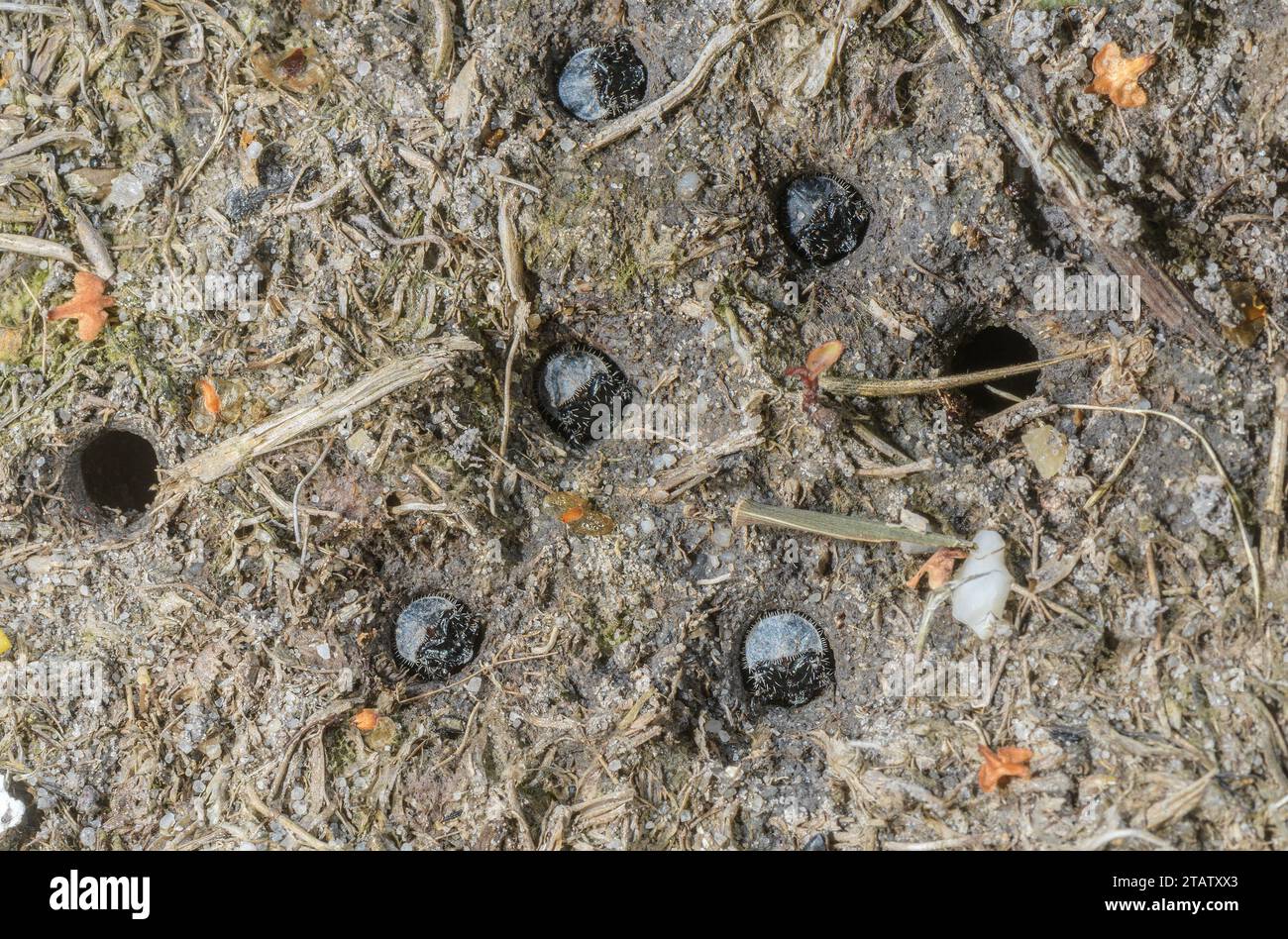 Larvae of Green tiger beetle, Cicindela campestris living in a group on damp heathland, Dorset. Stock Photohttps://www.alamy.com/image-license-details/?v=1https://www.alamy.com/larvae-of-green-tiger-beetle-cicindela-campestris-living-in-a-group-on-damp-heathland-dorset-image574636667.html
Larvae of Green tiger beetle, Cicindela campestris living in a group on damp heathland, Dorset. Stock Photohttps://www.alamy.com/image-license-details/?v=1https://www.alamy.com/larvae-of-green-tiger-beetle-cicindela-campestris-living-in-a-group-on-damp-heathland-dorset-image574636667.htmlRM2TATXX3–Larvae of Green tiger beetle, Cicindela campestris living in a group on damp heathland, Dorset.
 Tomato, Hornworm, Tobacco, Manduca Sexta Larvae of Five Spotted Hawk Moth covered in white cocoons of predatory Braconid Wasp Stock Photohttps://www.alamy.com/image-license-details/?v=1https://www.alamy.com/stock-photo-tomato-hornworm-tobacco-manduca-sexta-larvae-of-five-spotted-hawk-20665542.html
Tomato, Hornworm, Tobacco, Manduca Sexta Larvae of Five Spotted Hawk Moth covered in white cocoons of predatory Braconid Wasp Stock Photohttps://www.alamy.com/image-license-details/?v=1https://www.alamy.com/stock-photo-tomato-hornworm-tobacco-manduca-sexta-larvae-of-five-spotted-hawk-20665542.htmlRMB5HB32–Tomato, Hornworm, Tobacco, Manduca Sexta Larvae of Five Spotted Hawk Moth covered in white cocoons of predatory Braconid Wasp
 Black-headed cardinal beetle larva (Pyrochroa coccinea), a flattened saprophytic larva found in decaying wood. Stock Photohttps://www.alamy.com/image-license-details/?v=1https://www.alamy.com/black-headed-cardinal-beetle-larva-pyrochroa-coccinea-a-flattened-saprophytic-larva-found-in-decaying-wood-image502796243.html
Black-headed cardinal beetle larva (Pyrochroa coccinea), a flattened saprophytic larva found in decaying wood. Stock Photohttps://www.alamy.com/image-license-details/?v=1https://www.alamy.com/black-headed-cardinal-beetle-larva-pyrochroa-coccinea-a-flattened-saprophytic-larva-found-in-decaying-wood-image502796243.htmlRF2M609MK–Black-headed cardinal beetle larva (Pyrochroa coccinea), a flattened saprophytic larva found in decaying wood.
 Chrysopidae, neuropterans, Green lacewing larva, Most species of lacewings and their larvae are active predators, and are often used for bio. control Stock Photohttps://www.alamy.com/image-license-details/?v=1https://www.alamy.com/stock-image-chrysopidae-neuropterans-green-lacewing-larva-most-species-of-lacewings-161771758.html
Chrysopidae, neuropterans, Green lacewing larva, Most species of lacewings and their larvae are active predators, and are often used for bio. control Stock Photohttps://www.alamy.com/image-license-details/?v=1https://www.alamy.com/stock-image-chrysopidae-neuropterans-green-lacewing-larva-most-species-of-lacewings-161771758.htmlRFKB59EP–Chrysopidae, neuropterans, Green lacewing larva, Most species of lacewings and their larvae are active predators, and are often used for bio. control
 Aphid Predatory Midge (Aphidoletes aphidimyza), larva of the Aphid Predatory Midge feeding on aphids, Aaphis spec., Germany, Bavaria Stock Photohttps://www.alamy.com/image-license-details/?v=1https://www.alamy.com/stock-photo-aphid-predatory-midge-aphidoletes-aphidimyza-larva-of-the-aphid-predatory-47922851.html
Aphid Predatory Midge (Aphidoletes aphidimyza), larva of the Aphid Predatory Midge feeding on aphids, Aaphis spec., Germany, Bavaria Stock Photohttps://www.alamy.com/image-license-details/?v=1https://www.alamy.com/stock-photo-aphid-predatory-midge-aphidoletes-aphidimyza-larva-of-the-aphid-predatory-47922851.htmlRMCNY22B–Aphid Predatory Midge (Aphidoletes aphidimyza), larva of the Aphid Predatory Midge feeding on aphids, Aaphis spec., Germany, Bavaria
 Myrmeleonidae - Antlion insect in the family Myrmeleontidae, known for the fiercely predatory habits of their larvae, which in many species dig pits Stock Photohttps://www.alamy.com/image-license-details/?v=1https://www.alamy.com/myrmeleonidae-antlion-insect-in-the-family-myrmeleontidae-known-for-the-fiercely-predatory-habits-of-their-larvae-which-in-many-species-dig-pits-image262848900.html
Myrmeleonidae - Antlion insect in the family Myrmeleontidae, known for the fiercely predatory habits of their larvae, which in many species dig pits Stock Photohttps://www.alamy.com/image-license-details/?v=1https://www.alamy.com/myrmeleonidae-antlion-insect-in-the-family-myrmeleontidae-known-for-the-fiercely-predatory-habits-of-their-larvae-which-in-many-species-dig-pits-image262848900.htmlRFW7HPCM–Myrmeleonidae - Antlion insect in the family Myrmeleontidae, known for the fiercely predatory habits of their larvae, which in many species dig pits
 Aphid Predatory Midge (Aphidoletes aphidimyza), larva of the Aphid Predatory Midge feeding on aphids, Aaphis spec., Germany, Bavaria Stock Photohttps://www.alamy.com/image-license-details/?v=1https://www.alamy.com/stock-photo-aphid-predatory-midge-aphidoletes-aphidimyza-larva-of-the-aphid-predatory-47922847.html
Aphid Predatory Midge (Aphidoletes aphidimyza), larva of the Aphid Predatory Midge feeding on aphids, Aaphis spec., Germany, Bavaria Stock Photohttps://www.alamy.com/image-license-details/?v=1https://www.alamy.com/stock-photo-aphid-predatory-midge-aphidoletes-aphidimyza-larva-of-the-aphid-predatory-47922847.htmlRMCNY227–Aphid Predatory Midge (Aphidoletes aphidimyza), larva of the Aphid Predatory Midge feeding on aphids, Aaphis spec., Germany, Bavaria
 Eyed Ladybird Larva (Anatis ocellata) Stock Photohttps://www.alamy.com/image-license-details/?v=1https://www.alamy.com/eyed-ladybird-larva-anatis-ocellata-image614171837.html
Eyed Ladybird Larva (Anatis ocellata) Stock Photohttps://www.alamy.com/image-license-details/?v=1https://www.alamy.com/eyed-ladybird-larva-anatis-ocellata-image614171837.htmlRF2XK5XCD–Eyed Ladybird Larva (Anatis ocellata)
 Predatory mite Hypoaspis miles a sciarid shore fly predator Stock Photohttps://www.alamy.com/image-license-details/?v=1https://www.alamy.com/predatory-mite-hypoaspis-miles-a-sciarid-shore-fly-predator-image3344237.html
Predatory mite Hypoaspis miles a sciarid shore fly predator Stock Photohttps://www.alamy.com/image-license-details/?v=1https://www.alamy.com/predatory-mite-hypoaspis-miles-a-sciarid-shore-fly-predator-image3344237.htmlRMA1FK6E–Predatory mite Hypoaspis miles a sciarid shore fly predator
 The life and metamorphoses of the Dragonfly (Libellulidae Depressa). A: The adult insect; B: The insect casting its old nymphs skin; C&D: larvae and Nymph. Dragonflies, an insect belonging to the order Odonata, infraorder Anisoptera, are predators, both in their aquatic larval stage, when they are known as nymphs or naiads, and as adults. Several years of their lives are spent as nymphs living in fresh water; the adults may be on the wing for just a few days or weeks. They are fast, agile fliers, sometimes migrating across oceans, and often live near water. Stock Photohttps://www.alamy.com/image-license-details/?v=1https://www.alamy.com/the-life-and-metamorphoses-of-the-dragonfly-libellulidae-depressa-a-the-adult-insect-b-the-insect-casting-its-old-nymphs-skin-cd-larvae-and-nymph-dragonflies-an-insect-belonging-to-the-order-odonata-infraorder-anisoptera-are-predators-both-in-their-aquatic-larval-stage-when-they-are-known-as-nymphs-or-naiads-and-as-adults-several-years-of-their-lives-are-spent-as-nymphs-living-in-fresh-water-the-adults-may-be-on-the-wing-for-just-a-few-days-or-weeks-they-are-fast-agile-fliers-sometimes-migrating-across-oceans-and-often-live-near-water-image335591798.html
The life and metamorphoses of the Dragonfly (Libellulidae Depressa). A: The adult insect; B: The insect casting its old nymphs skin; C&D: larvae and Nymph. Dragonflies, an insect belonging to the order Odonata, infraorder Anisoptera, are predators, both in their aquatic larval stage, when they are known as nymphs or naiads, and as adults. Several years of their lives are spent as nymphs living in fresh water; the adults may be on the wing for just a few days or weeks. They are fast, agile fliers, sometimes migrating across oceans, and often live near water. Stock Photohttps://www.alamy.com/image-license-details/?v=1https://www.alamy.com/the-life-and-metamorphoses-of-the-dragonfly-libellulidae-depressa-a-the-adult-insect-b-the-insect-casting-its-old-nymphs-skin-cd-larvae-and-nymph-dragonflies-an-insect-belonging-to-the-order-odonata-infraorder-anisoptera-are-predators-both-in-their-aquatic-larval-stage-when-they-are-known-as-nymphs-or-naiads-and-as-adults-several-years-of-their-lives-are-spent-as-nymphs-living-in-fresh-water-the-adults-may-be-on-the-wing-for-just-a-few-days-or-weeks-they-are-fast-agile-fliers-sometimes-migrating-across-oceans-and-often-live-near-water-image335591798.htmlRM2ADYENA–The life and metamorphoses of the Dragonfly (Libellulidae Depressa). A: The adult insect; B: The insect casting its old nymphs skin; C&D: larvae and Nymph. Dragonflies, an insect belonging to the order Odonata, infraorder Anisoptera, are predators, both in their aquatic larval stage, when they are known as nymphs or naiads, and as adults. Several years of their lives are spent as nymphs living in fresh water; the adults may be on the wing for just a few days or weeks. They are fast, agile fliers, sometimes migrating across oceans, and often live near water.
 Predatory midge (Aphidoletes aphidimyza) aphid predator with greenfly prey Stock Photohttps://www.alamy.com/image-license-details/?v=1https://www.alamy.com/stock-photo-predatory-midge-aphidoletes-aphidimyza-aphid-predator-with-greenfly-30109244.html
Predatory midge (Aphidoletes aphidimyza) aphid predator with greenfly prey Stock Photohttps://www.alamy.com/image-license-details/?v=1https://www.alamy.com/stock-photo-predatory-midge-aphidoletes-aphidimyza-aphid-predator-with-greenfly-30109244.htmlRMBMYGJ4–Predatory midge (Aphidoletes aphidimyza) aphid predator with greenfly prey
 Great Diving Beetle Larvae (Dytiscus marginalis) feeding on Dragonfly. Stock Photohttps://www.alamy.com/image-license-details/?v=1https://www.alamy.com/stock-photo-great-diving-beetle-larvae-dytiscus-marginalis-feeding-on-dragonfly-18593793.html
Great Diving Beetle Larvae (Dytiscus marginalis) feeding on Dragonfly. Stock Photohttps://www.alamy.com/image-license-details/?v=1https://www.alamy.com/stock-photo-great-diving-beetle-larvae-dytiscus-marginalis-feeding-on-dragonfly-18593793.htmlRMB270G1–Great Diving Beetle Larvae (Dytiscus marginalis) feeding on Dragonfly.
 Adult predatory midge (Aphidoletes aphidimyza) larvae are aphid predatord Stock Photohttps://www.alamy.com/image-license-details/?v=1https://www.alamy.com/stock-photo-adult-predatory-midge-aphidoletes-aphidimyza-larvae-are-aphid-predatord-33752191.html
Adult predatory midge (Aphidoletes aphidimyza) larvae are aphid predatord Stock Photohttps://www.alamy.com/image-license-details/?v=1https://www.alamy.com/stock-photo-adult-predatory-midge-aphidoletes-aphidimyza-larvae-are-aphid-predatord-33752191.htmlRMBXWF7B–Adult predatory midge (Aphidoletes aphidimyza) larvae are aphid predatord
 Hemerobius, Print, Hemerobius is a genus of lacewings in the family Hemerobiidae. It is found throughout Europe and North America. Like most lacewings, both the larvae and adults are predatory, primarily eating acarines, scale insects, psyllids, aphids, thrips, and the eggs of lepidopterans and whiteflies Stock Photohttps://www.alamy.com/image-license-details/?v=1https://www.alamy.com/hemerobius-print-hemerobius-is-a-genus-of-lacewings-in-the-family-hemerobiidae-it-is-found-throughout-europe-and-north-america-like-most-lacewings-both-the-larvae-and-adults-are-predatory-primarily-eating-acarines-scale-insects-psyllids-aphids-thrips-and-the-eggs-of-lepidopterans-and-whiteflies-image328683666.html
Hemerobius, Print, Hemerobius is a genus of lacewings in the family Hemerobiidae. It is found throughout Europe and North America. Like most lacewings, both the larvae and adults are predatory, primarily eating acarines, scale insects, psyllids, aphids, thrips, and the eggs of lepidopterans and whiteflies Stock Photohttps://www.alamy.com/image-license-details/?v=1https://www.alamy.com/hemerobius-print-hemerobius-is-a-genus-of-lacewings-in-the-family-hemerobiidae-it-is-found-throughout-europe-and-north-america-like-most-lacewings-both-the-larvae-and-adults-are-predatory-primarily-eating-acarines-scale-insects-psyllids-aphids-thrips-and-the-eggs-of-lepidopterans-and-whiteflies-image328683666.htmlRM2A2MRAA–Hemerobius, Print, Hemerobius is a genus of lacewings in the family Hemerobiidae. It is found throughout Europe and North America. Like most lacewings, both the larvae and adults are predatory, primarily eating acarines, scale insects, psyllids, aphids, thrips, and the eggs of lepidopterans and whiteflies
 Predatory midge larvae (Aphidoletes aphidimyza) feeding on chrysanthemum aphids Stock Photohttps://www.alamy.com/image-license-details/?v=1https://www.alamy.com/stock-photo-predatory-midge-larvae-aphidoletes-aphidimyza-feeding-on-chrysanthemum-49073222.html
Predatory midge larvae (Aphidoletes aphidimyza) feeding on chrysanthemum aphids Stock Photohttps://www.alamy.com/image-license-details/?v=1https://www.alamy.com/stock-photo-predatory-midge-larvae-aphidoletes-aphidimyza-feeding-on-chrysanthemum-49073222.htmlRMCRRDB2–Predatory midge larvae (Aphidoletes aphidimyza) feeding on chrysanthemum aphids
 predatory bushcricket (Saga pedo), larva of a predatory bushcricket on yellow flowers, Bulgaria, Oblast Plewen Stock Photohttps://www.alamy.com/image-license-details/?v=1https://www.alamy.com/stock-photo-predatory-bushcricket-saga-pedo-larva-of-a-predatory-bushcricket-on-76083268.html
predatory bushcricket (Saga pedo), larva of a predatory bushcricket on yellow flowers, Bulgaria, Oblast Plewen Stock Photohttps://www.alamy.com/image-license-details/?v=1https://www.alamy.com/stock-photo-predatory-bushcricket-saga-pedo-larva-of-a-predatory-bushcricket-on-76083268.htmlRMEBNTYG–predatory bushcricket (Saga pedo), larva of a predatory bushcricket on yellow flowers, Bulgaria, Oblast Plewen
 Predatory midge larvae (Aphidoletes aphidimyza) feeding on chrysanthemum aphids Stock Photohttps://www.alamy.com/image-license-details/?v=1https://www.alamy.com/stock-photo-predatory-midge-larvae-aphidoletes-aphidimyza-feeding-on-chrysanthemum-49073309.html
Predatory midge larvae (Aphidoletes aphidimyza) feeding on chrysanthemum aphids Stock Photohttps://www.alamy.com/image-license-details/?v=1https://www.alamy.com/stock-photo-predatory-midge-larvae-aphidoletes-aphidimyza-feeding-on-chrysanthemum-49073309.htmlRMCRRDE5–Predatory midge larvae (Aphidoletes aphidimyza) feeding on chrysanthemum aphids
 Dragonfly larvae - Southern Hawker (Aeshna cyanea). Stock Photohttps://www.alamy.com/image-license-details/?v=1https://www.alamy.com/dragonfly-larvae-southern-hawker-aeshna-cyanea-image7385296.html
Dragonfly larvae - Southern Hawker (Aeshna cyanea). Stock Photohttps://www.alamy.com/image-license-details/?v=1https://www.alamy.com/dragonfly-larvae-southern-hawker-aeshna-cyanea-image7385296.htmlRMABMBW1–Dragonfly larvae - Southern Hawker (Aeshna cyanea).
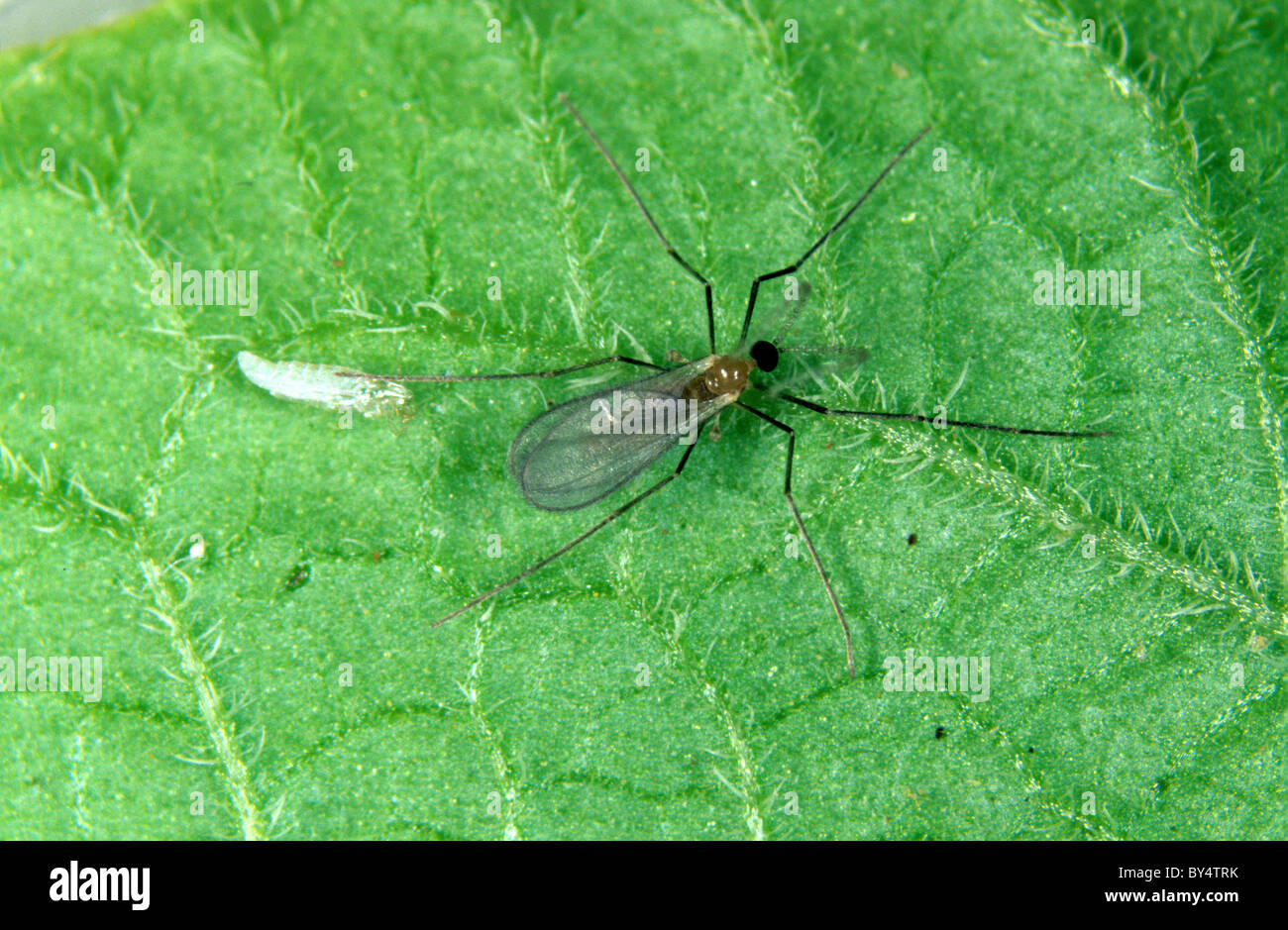 Adult predatory midge (Aphidoletes aphidimyza) larvae are aphid predators Stock Photohttps://www.alamy.com/image-license-details/?v=1https://www.alamy.com/stock-photo-adult-predatory-midge-aphidoletes-aphidimyza-larvae-are-aphid-predators-33913367.html
Adult predatory midge (Aphidoletes aphidimyza) larvae are aphid predators Stock Photohttps://www.alamy.com/image-license-details/?v=1https://www.alamy.com/stock-photo-adult-predatory-midge-aphidoletes-aphidimyza-larvae-are-aphid-predators-33913367.htmlRMBY4TRK–Adult predatory midge (Aphidoletes aphidimyza) larvae are aphid predators
 Larvae of Green tiger beetle, Cicindela campestris living in a group on damp heathland, Dorset. Stock Photohttps://www.alamy.com/image-license-details/?v=1https://www.alamy.com/larvae-of-green-tiger-beetle-cicindela-campestris-living-in-a-group-on-damp-heathland-dorset-image574636622.html
Larvae of Green tiger beetle, Cicindela campestris living in a group on damp heathland, Dorset. Stock Photohttps://www.alamy.com/image-license-details/?v=1https://www.alamy.com/larvae-of-green-tiger-beetle-cicindela-campestris-living-in-a-group-on-damp-heathland-dorset-image574636622.htmlRM2TATXTE–Larvae of Green tiger beetle, Cicindela campestris living in a group on damp heathland, Dorset.
 Adult predatory midge (Aphidoletes aphidimyza) larvae are aphid predators Stock Photohttps://www.alamy.com/image-license-details/?v=1https://www.alamy.com/stock-photo-adult-predatory-midge-aphidoletes-aphidimyza-larvae-are-aphid-predators-33813805.html
Adult predatory midge (Aphidoletes aphidimyza) larvae are aphid predators Stock Photohttps://www.alamy.com/image-license-details/?v=1https://www.alamy.com/stock-photo-adult-predatory-midge-aphidoletes-aphidimyza-larvae-are-aphid-predators-33813805.htmlRMBY09RW–Adult predatory midge (Aphidoletes aphidimyza) larvae are aphid predators
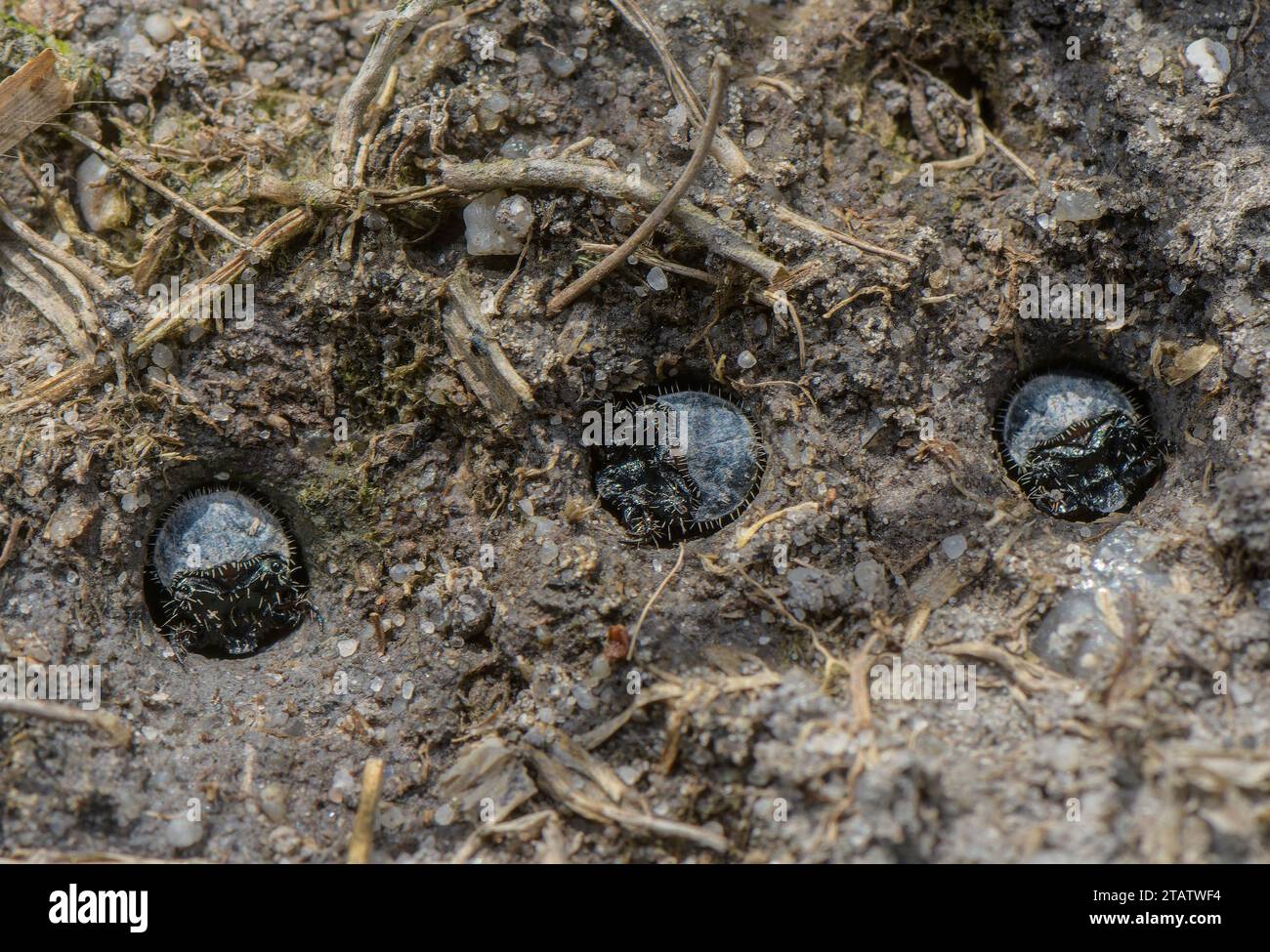 Larvae of Green tiger beetle, Cicindela campestris living in a group on damp heathland, Dorset. Stock Photohttps://www.alamy.com/image-license-details/?v=1https://www.alamy.com/larvae-of-green-tiger-beetle-cicindela-campestris-living-in-a-group-on-damp-heathland-dorset-image574635576.html
Larvae of Green tiger beetle, Cicindela campestris living in a group on damp heathland, Dorset. Stock Photohttps://www.alamy.com/image-license-details/?v=1https://www.alamy.com/larvae-of-green-tiger-beetle-cicindela-campestris-living-in-a-group-on-damp-heathland-dorset-image574635576.htmlRM2TATWF4–Larvae of Green tiger beetle, Cicindela campestris living in a group on damp heathland, Dorset.
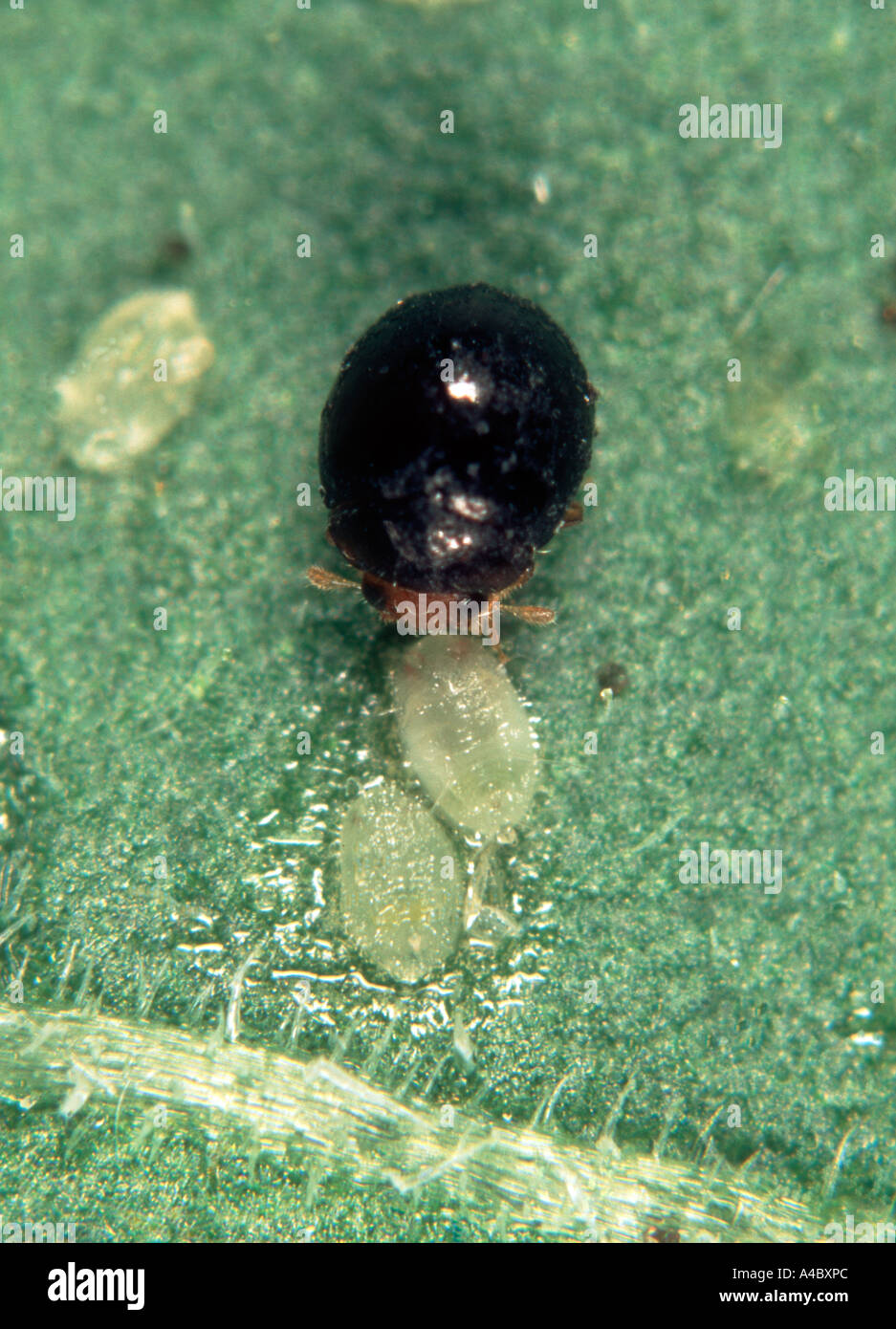 Predatory ladybird Delphastus catalinae feeding on whitefly scales Stock Photohttps://www.alamy.com/image-license-details/?v=1https://www.alamy.com/predatory-ladybird-delphastus-catalinae-feeding-on-whitefly-scales-image6286059.html
Predatory ladybird Delphastus catalinae feeding on whitefly scales Stock Photohttps://www.alamy.com/image-license-details/?v=1https://www.alamy.com/predatory-ladybird-delphastus-catalinae-feeding-on-whitefly-scales-image6286059.htmlRMA4BXPC–Predatory ladybird Delphastus catalinae feeding on whitefly scales
 Larvae of Green tiger beetle, Cicindela campestris living in a group on damp heathland, Dorset. Stock Photohttps://www.alamy.com/image-license-details/?v=1https://www.alamy.com/larvae-of-green-tiger-beetle-cicindela-campestris-living-in-a-group-on-damp-heathland-dorset-image574635483.html
Larvae of Green tiger beetle, Cicindela campestris living in a group on damp heathland, Dorset. Stock Photohttps://www.alamy.com/image-license-details/?v=1https://www.alamy.com/larvae-of-green-tiger-beetle-cicindela-campestris-living-in-a-group-on-damp-heathland-dorset-image574635483.htmlRM2TATWBR–Larvae of Green tiger beetle, Cicindela campestris living in a group on damp heathland, Dorset.
 Myrmeleonidae - Antlion insect in the family Myrmeleontidae, known for the fiercely predatory habits of their larvae, which in many species dig pits Stock Photohttps://www.alamy.com/image-license-details/?v=1https://www.alamy.com/myrmeleonidae-antlion-insect-in-the-family-myrmeleontidae-known-for-the-fiercely-predatory-habits-of-their-larvae-which-in-many-species-dig-pits-image262849008.html
Myrmeleonidae - Antlion insect in the family Myrmeleontidae, known for the fiercely predatory habits of their larvae, which in many species dig pits Stock Photohttps://www.alamy.com/image-license-details/?v=1https://www.alamy.com/myrmeleonidae-antlion-insect-in-the-family-myrmeleontidae-known-for-the-fiercely-predatory-habits-of-their-larvae-which-in-many-species-dig-pits-image262849008.htmlRFW7HPGG–Myrmeleonidae - Antlion insect in the family Myrmeleontidae, known for the fiercely predatory habits of their larvae, which in many species dig pits
 Predatory midge Aphidoletes aphidimyza aphid predator with greenfly prey Stock Photohttps://www.alamy.com/image-license-details/?v=1https://www.alamy.com/stock-photo-predatory-midge-aphidoletes-aphidimyza-aphid-predator-with-greenfly-16480423.html
Predatory midge Aphidoletes aphidimyza aphid predator with greenfly prey Stock Photohttps://www.alamy.com/image-license-details/?v=1https://www.alamy.com/stock-photo-predatory-midge-aphidoletes-aphidimyza-aphid-predator-with-greenfly-16480423.htmlRMAW6BFM–Predatory midge Aphidoletes aphidimyza aphid predator with greenfly prey
 Eyed Ladybird Larva (Anatis ocellata) Stock Photohttps://www.alamy.com/image-license-details/?v=1https://www.alamy.com/eyed-ladybird-larva-anatis-ocellata-image614171835.html
Eyed Ladybird Larva (Anatis ocellata) Stock Photohttps://www.alamy.com/image-license-details/?v=1https://www.alamy.com/eyed-ladybird-larva-anatis-ocellata-image614171835.htmlRF2XK5XCB–Eyed Ladybird Larva (Anatis ocellata)
 Chrysopidae lacewing predatory larva isolated on white background Stock Photohttps://www.alamy.com/image-license-details/?v=1https://www.alamy.com/chrysopidae-lacewing-predatory-larva-isolated-on-white-background-image258855860.html
Chrysopidae lacewing predatory larva isolated on white background Stock Photohttps://www.alamy.com/image-license-details/?v=1https://www.alamy.com/chrysopidae-lacewing-predatory-larva-isolated-on-white-background-image258855860.htmlRMW13W84–Chrysopidae lacewing predatory larva isolated on white background
 The Ichneumonidae are a parasitoid wasp family within the order Hymenoptera. Unlike other parasites, parasitoids kill their hosts like larvae and pupae of Coleoptera (beetles) and Hymenoptera (wasps and relatives). As seen they also feed on the Caterpillars of Lepidoptera (moths and butterflies). Stock Photohttps://www.alamy.com/image-license-details/?v=1https://www.alamy.com/the-ichneumonidae-are-a-parasitoid-wasp-family-within-the-order-hymenoptera-unlike-other-parasites-parasitoids-kill-their-hosts-like-larvae-and-pupae-of-coleoptera-beetles-and-hymenoptera-wasps-and-relatives-as-seen-they-also-feed-on-the-caterpillars-of-lepidoptera-moths-and-butterflies-image335592971.html
The Ichneumonidae are a parasitoid wasp family within the order Hymenoptera. Unlike other parasites, parasitoids kill their hosts like larvae and pupae of Coleoptera (beetles) and Hymenoptera (wasps and relatives). As seen they also feed on the Caterpillars of Lepidoptera (moths and butterflies). Stock Photohttps://www.alamy.com/image-license-details/?v=1https://www.alamy.com/the-ichneumonidae-are-a-parasitoid-wasp-family-within-the-order-hymenoptera-unlike-other-parasites-parasitoids-kill-their-hosts-like-larvae-and-pupae-of-coleoptera-beetles-and-hymenoptera-wasps-and-relatives-as-seen-they-also-feed-on-the-caterpillars-of-lepidoptera-moths-and-butterflies-image335592971.htmlRM2ADYG77–The Ichneumonidae are a parasitoid wasp family within the order Hymenoptera. Unlike other parasites, parasitoids kill their hosts like larvae and pupae of Coleoptera (beetles) and Hymenoptera (wasps and relatives). As seen they also feed on the Caterpillars of Lepidoptera (moths and butterflies).
 Microscopically sized larvae of predatory beetle Cybocephalus politus in colony of Pseudaulacaspis pentagona, white peach scale on bark of fruit tree Stock Photohttps://www.alamy.com/image-license-details/?v=1https://www.alamy.com/microscopically-sized-larvae-of-predatory-beetle-cybocephalus-politus-in-colony-of-pseudaulacaspis-pentagona-white-peach-scale-on-bark-of-fruit-tree-image620703413.html
Microscopically sized larvae of predatory beetle Cybocephalus politus in colony of Pseudaulacaspis pentagona, white peach scale on bark of fruit tree Stock Photohttps://www.alamy.com/image-license-details/?v=1https://www.alamy.com/microscopically-sized-larvae-of-predatory-beetle-cybocephalus-politus-in-colony-of-pseudaulacaspis-pentagona-white-peach-scale-on-bark-of-fruit-tree-image620703413.htmlRF2Y1RDF1–Microscopically sized larvae of predatory beetle Cybocephalus politus in colony of Pseudaulacaspis pentagona, white peach scale on bark of fruit tree
 Great Diving Beetle Larvae (Dytiscus marginalis) feeding on Dragonfly. Stock Photohttps://www.alamy.com/image-license-details/?v=1https://www.alamy.com/stock-photo-great-diving-beetle-larvae-dytiscus-marginalis-feeding-on-dragonfly-18591604.html
Great Diving Beetle Larvae (Dytiscus marginalis) feeding on Dragonfly. Stock Photohttps://www.alamy.com/image-license-details/?v=1https://www.alamy.com/stock-photo-great-diving-beetle-larvae-dytiscus-marginalis-feeding-on-dragonfly-18591604.htmlRMB26WNT–Great Diving Beetle Larvae (Dytiscus marginalis) feeding on Dragonfly.
 Wasp Nest with larvae and eggs in individual cell of the hive closeup macro Stock Photohttps://www.alamy.com/image-license-details/?v=1https://www.alamy.com/stock-photo-wasp-nest-with-larvae-and-eggs-in-individual-cell-of-the-hive-closeup-111768845.html
Wasp Nest with larvae and eggs in individual cell of the hive closeup macro Stock Photohttps://www.alamy.com/image-license-details/?v=1https://www.alamy.com/stock-photo-wasp-nest-with-larvae-and-eggs-in-individual-cell-of-the-hive-closeup-111768845.htmlRFGDRE8D–Wasp Nest with larvae and eggs in individual cell of the hive closeup macro
 Helvella is a genus of ascomycete fungus of the family Helvellaceae. The mushrooms, commonly known as elfin saddles, are identified by their irregularly shaped caps, fluted stems, and fuzzy undersurfaces. They are found in North America and in Europe. Well known species include the whitish H. crispa and the grey H. lacunosa. They have been reported to cause gastrointestinal symptoms when eaten raw. and Hemerobius is a genus of lacewings in the family Hemerobiidae. It is found throughout Europe and North America. Like most lacewings, both the larvae and adults are predatory, primarily eating ac Stock Photohttps://www.alamy.com/image-license-details/?v=1https://www.alamy.com/helvella-is-a-genus-of-ascomycete-fungus-of-the-family-helvellaceae-the-mushrooms-commonly-known-as-elfin-saddles-are-identified-by-their-irregularly-shaped-caps-fluted-stems-and-fuzzy-undersurfaces-they-are-found-in-north-america-and-in-europe-well-known-species-include-the-whitish-h-crispa-and-the-grey-h-lacunosa-they-have-been-reported-to-cause-gastrointestinal-symptoms-when-eaten-raw-and-hemerobius-is-a-genus-of-lacewings-in-the-family-hemerobiidae-it-is-found-throughout-europe-and-north-america-like-most-lacewings-both-the-larvae-and-adults-are-predatory-primarily-eating-ac-image434748560.html
Helvella is a genus of ascomycete fungus of the family Helvellaceae. The mushrooms, commonly known as elfin saddles, are identified by their irregularly shaped caps, fluted stems, and fuzzy undersurfaces. They are found in North America and in Europe. Well known species include the whitish H. crispa and the grey H. lacunosa. They have been reported to cause gastrointestinal symptoms when eaten raw. and Hemerobius is a genus of lacewings in the family Hemerobiidae. It is found throughout Europe and North America. Like most lacewings, both the larvae and adults are predatory, primarily eating ac Stock Photohttps://www.alamy.com/image-license-details/?v=1https://www.alamy.com/helvella-is-a-genus-of-ascomycete-fungus-of-the-family-helvellaceae-the-mushrooms-commonly-known-as-elfin-saddles-are-identified-by-their-irregularly-shaped-caps-fluted-stems-and-fuzzy-undersurfaces-they-are-found-in-north-america-and-in-europe-well-known-species-include-the-whitish-h-crispa-and-the-grey-h-lacunosa-they-have-been-reported-to-cause-gastrointestinal-symptoms-when-eaten-raw-and-hemerobius-is-a-genus-of-lacewings-in-the-family-hemerobiidae-it-is-found-throughout-europe-and-north-america-like-most-lacewings-both-the-larvae-and-adults-are-predatory-primarily-eating-ac-image434748560.htmlRM2G78E68–Helvella is a genus of ascomycete fungus of the family Helvellaceae. The mushrooms, commonly known as elfin saddles, are identified by their irregularly shaped caps, fluted stems, and fuzzy undersurfaces. They are found in North America and in Europe. Well known species include the whitish H. crispa and the grey H. lacunosa. They have been reported to cause gastrointestinal symptoms when eaten raw. and Hemerobius is a genus of lacewings in the family Hemerobiidae. It is found throughout Europe and North America. Like most lacewings, both the larvae and adults are predatory, primarily eating ac
 Pyrochroa coccinea cardinal beetle larva. Head and mandibles of insect in the family Pyrochroidae, showing flattened shape Stock Photohttps://www.alamy.com/image-license-details/?v=1https://www.alamy.com/stock-photo-pyrochroa-coccinea-cardinal-beetle-larva-head-and-mandibles-of-insect-130496474.html
Pyrochroa coccinea cardinal beetle larva. Head and mandibles of insect in the family Pyrochroidae, showing flattened shape Stock Photohttps://www.alamy.com/image-license-details/?v=1https://www.alamy.com/stock-photo-pyrochroa-coccinea-cardinal-beetle-larva-head-and-mandibles-of-insect-130496474.htmlRFHG8HGA–Pyrochroa coccinea cardinal beetle larva. Head and mandibles of insect in the family Pyrochroidae, showing flattened shape
 predatory bushcricket (Saga pedo), larva of a predatory bushcricket on yellow flowers, Bulgaria, Oblast Plewen Stock Photohttps://www.alamy.com/image-license-details/?v=1https://www.alamy.com/stock-photo-predatory-bushcricket-saga-pedo-larva-of-a-predatory-bushcricket-on-76083269.html
predatory bushcricket (Saga pedo), larva of a predatory bushcricket on yellow flowers, Bulgaria, Oblast Plewen Stock Photohttps://www.alamy.com/image-license-details/?v=1https://www.alamy.com/stock-photo-predatory-bushcricket-saga-pedo-larva-of-a-predatory-bushcricket-on-76083269.htmlRMEBNTYH–predatory bushcricket (Saga pedo), larva of a predatory bushcricket on yellow flowers, Bulgaria, Oblast Plewen
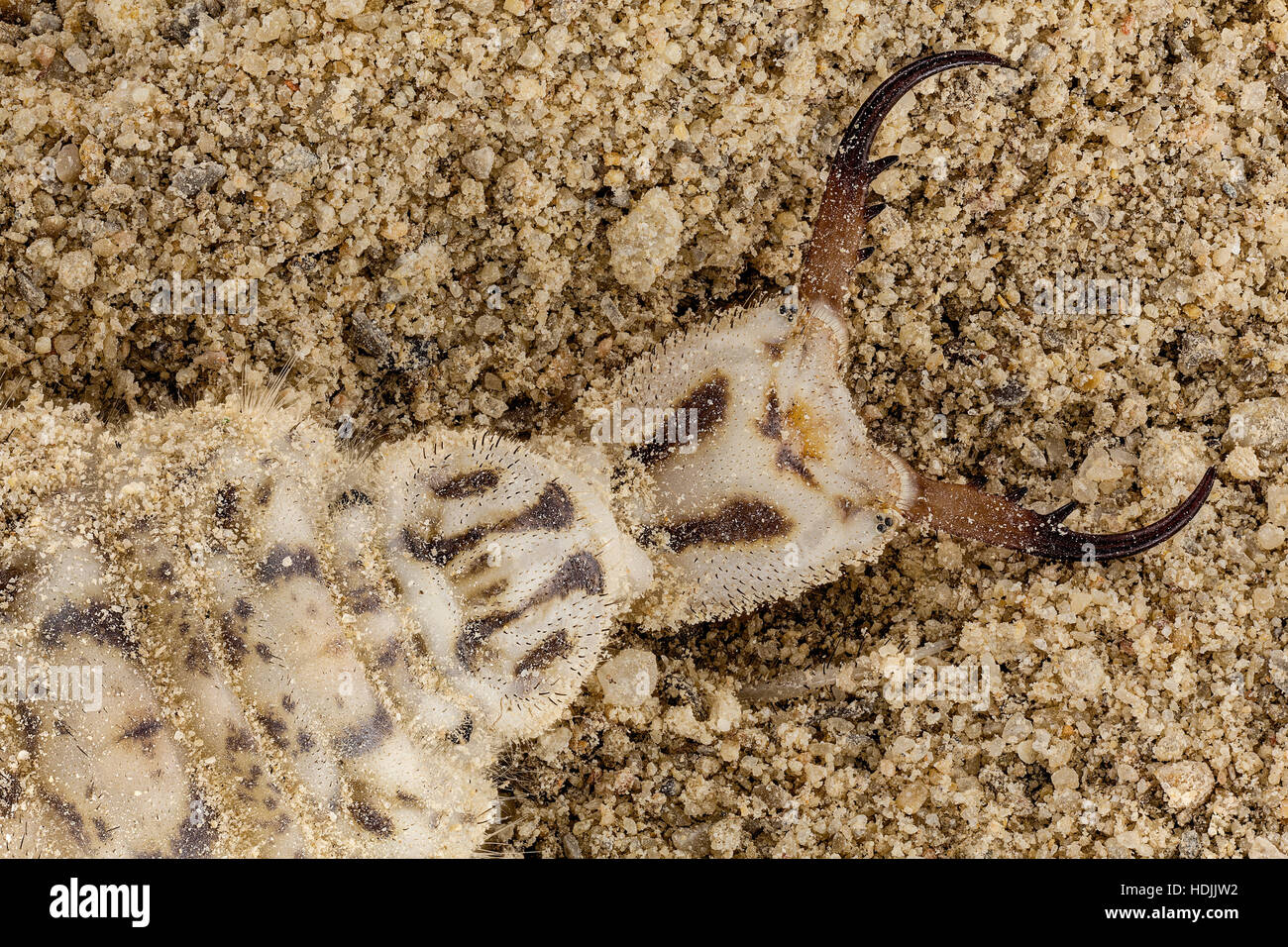 The antlions are a group of about 2,000 species of insect in the family Myrmeleontidae, known for the fiercely predatory habits of their larvae, which Stock Photohttps://www.alamy.com/image-license-details/?v=1https://www.alamy.com/stock-photo-the-antlions-are-a-group-of-about-2000-species-of-insect-in-the-family-128873054.html
The antlions are a group of about 2,000 species of insect in the family Myrmeleontidae, known for the fiercely predatory habits of their larvae, which Stock Photohttps://www.alamy.com/image-license-details/?v=1https://www.alamy.com/stock-photo-the-antlions-are-a-group-of-about-2000-species-of-insect-in-the-family-128873054.htmlRMHDJJW2–The antlions are a group of about 2,000 species of insect in the family Myrmeleontidae, known for the fiercely predatory habits of their larvae, which
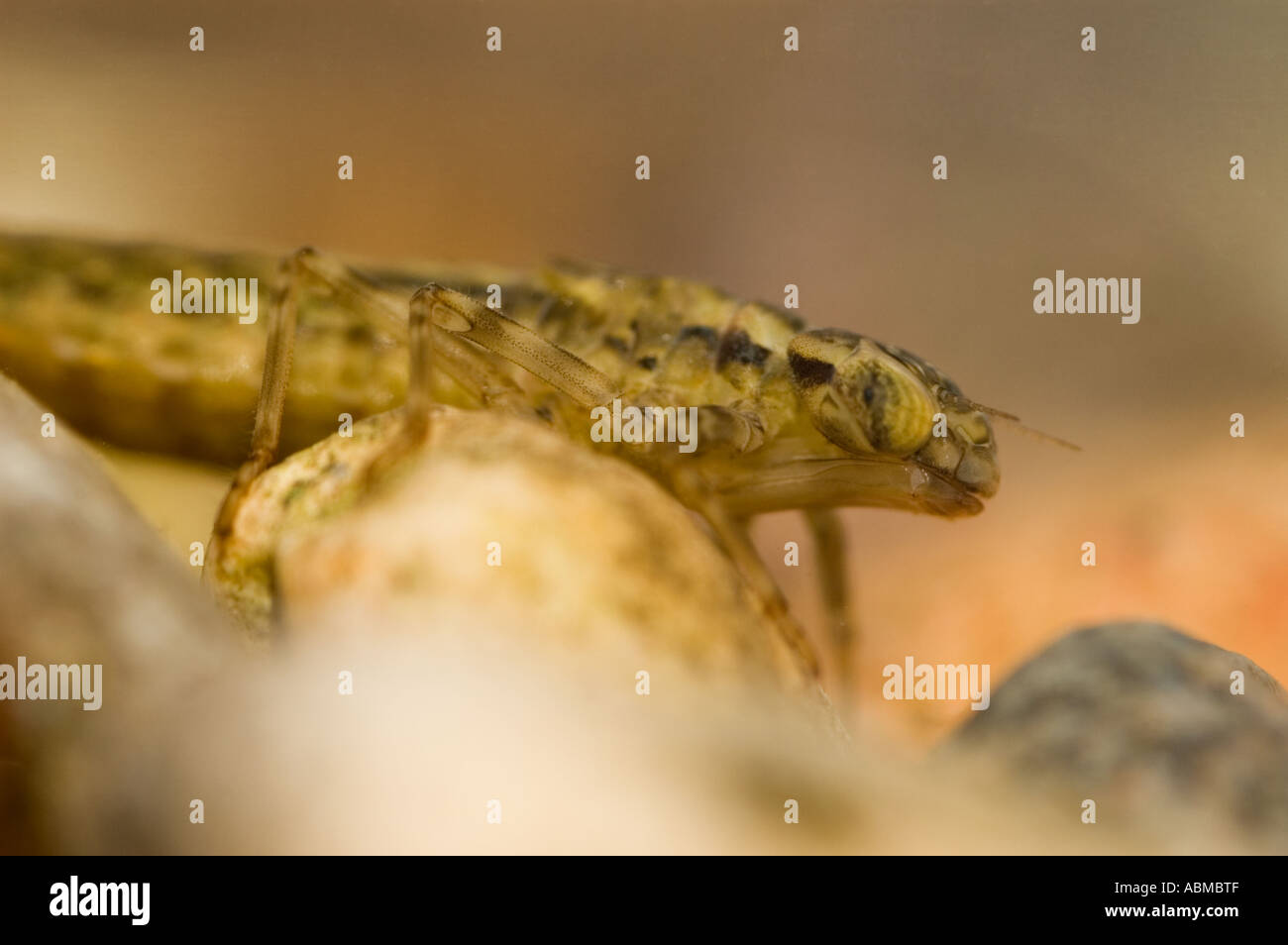 Dragonfly larvae - Southern Hawker (Aeshna cyanea). Stock Photohttps://www.alamy.com/image-license-details/?v=1https://www.alamy.com/dragonfly-larvae-southern-hawker-aeshna-cyanea-image7385294.html
Dragonfly larvae - Southern Hawker (Aeshna cyanea). Stock Photohttps://www.alamy.com/image-license-details/?v=1https://www.alamy.com/dragonfly-larvae-southern-hawker-aeshna-cyanea-image7385294.htmlRMABMBTF–Dragonfly larvae - Southern Hawker (Aeshna cyanea).
 Larva of Coccinella septempunctata (seven-spotted ladybug) Stock Photohttps://www.alamy.com/image-license-details/?v=1https://www.alamy.com/larva-of-coccinella-septempunctata-seven-spotted-ladybug-image342034927.html
Larva of Coccinella septempunctata (seven-spotted ladybug) Stock Photohttps://www.alamy.com/image-license-details/?v=1https://www.alamy.com/larva-of-coccinella-septempunctata-seven-spotted-ladybug-image342034927.htmlRF2ATD113–Larva of Coccinella septempunctata (seven-spotted ladybug)
 British dragonfly nymph casing Stock Photohttps://www.alamy.com/image-license-details/?v=1https://www.alamy.com/british-dragonfly-nymph-casing-image212938224.html
British dragonfly nymph casing Stock Photohttps://www.alamy.com/image-license-details/?v=1https://www.alamy.com/british-dragonfly-nymph-casing-image212938224.htmlRFPAC4TG–British dragonfly nymph casing
 Predatory mosquito (Toxorhynchites sp). The large size mosquito that their larvae eating other mosquito larvae. Stock Photohttps://www.alamy.com/image-license-details/?v=1https://www.alamy.com/stock-photo-predatory-mosquito-toxorhynchites-sp-the-large-size-mosquito-that-147826959.html
Predatory mosquito (Toxorhynchites sp). The large size mosquito that their larvae eating other mosquito larvae. Stock Photohttps://www.alamy.com/image-license-details/?v=1https://www.alamy.com/stock-photo-predatory-mosquito-toxorhynchites-sp-the-large-size-mosquito-that-147826959.htmlRFJGE2P7–Predatory mosquito (Toxorhynchites sp). The large size mosquito that their larvae eating other mosquito larvae.
 Green lacewing (Mallada signata) Stock Photohttps://www.alamy.com/image-license-details/?v=1https://www.alamy.com/stock-photo-green-lacewing-mallada-signata-122697858.html
Green lacewing (Mallada signata) Stock Photohttps://www.alamy.com/image-license-details/?v=1https://www.alamy.com/stock-photo-green-lacewing-mallada-signata-122697858.htmlRMH3HAAA–Green lacewing (Mallada signata)
 European hornet worker (Vespa crabro) busy constructing a nest and tending the larvae. Stock Photohttps://www.alamy.com/image-license-details/?v=1https://www.alamy.com/stock-photo-european-hornet-worker-vespa-crabro-busy-constructing-a-nest-and-tending-147805339.html
European hornet worker (Vespa crabro) busy constructing a nest and tending the larvae. Stock Photohttps://www.alamy.com/image-license-details/?v=1https://www.alamy.com/stock-photo-european-hornet-worker-vespa-crabro-busy-constructing-a-nest-and-tending-147805339.htmlRFJGD363–European hornet worker (Vespa crabro) busy constructing a nest and tending the larvae.
 Larvae of Green tiger beetle, Cicindela campestris living in a group on damp heathland, Dorset. Stock Photohttps://www.alamy.com/image-license-details/?v=1https://www.alamy.com/larvae-of-green-tiger-beetle-cicindela-campestris-living-in-a-group-on-damp-heathland-dorset-image574635465.html
Larvae of Green tiger beetle, Cicindela campestris living in a group on damp heathland, Dorset. Stock Photohttps://www.alamy.com/image-license-details/?v=1https://www.alamy.com/larvae-of-green-tiger-beetle-cicindela-campestris-living-in-a-group-on-damp-heathland-dorset-image574635465.htmlRM2TATWB5–Larvae of Green tiger beetle, Cicindela campestris living in a group on damp heathland, Dorset.
 Myrmeleonidae - Antlion insect in the family Myrmeleontidae, known for the fiercely predatory habits of their larvae, which in many species dig pits Stock Photohttps://www.alamy.com/image-license-details/?v=1https://www.alamy.com/myrmeleonidae-antlion-insect-in-the-family-myrmeleontidae-known-for-the-fiercely-predatory-habits-of-their-larvae-which-in-many-species-dig-pits-image262849042.html
Myrmeleonidae - Antlion insect in the family Myrmeleontidae, known for the fiercely predatory habits of their larvae, which in many species dig pits Stock Photohttps://www.alamy.com/image-license-details/?v=1https://www.alamy.com/myrmeleonidae-antlion-insect-in-the-family-myrmeleontidae-known-for-the-fiercely-predatory-habits-of-their-larvae-which-in-many-species-dig-pits-image262849042.htmlRFW7HPHP–Myrmeleonidae - Antlion insect in the family Myrmeleontidae, known for the fiercely predatory habits of their larvae, which in many species dig pits
 a big praying mantis on human hand closeup outdoor Stock Photohttps://www.alamy.com/image-license-details/?v=1https://www.alamy.com/stock-photo-a-big-praying-mantis-on-human-hand-closeup-outdoor-137605982.html
a big praying mantis on human hand closeup outdoor Stock Photohttps://www.alamy.com/image-license-details/?v=1https://www.alamy.com/stock-photo-a-big-praying-mantis-on-human-hand-closeup-outdoor-137605982.htmlRFHYTDRA–a big praying mantis on human hand closeup outdoor
 Snakefly larvae Stock Photohttps://www.alamy.com/image-license-details/?v=1https://www.alamy.com/snakefly-larvae-image449650447.html
Snakefly larvae Stock Photohttps://www.alamy.com/image-license-details/?v=1https://www.alamy.com/snakefly-larvae-image449650447.htmlRF2H3F9MF–Snakefly larvae
 Cryptolaemus ladybird beetle larvae attacking citrus mealybugs Stock Photohttps://www.alamy.com/image-license-details/?v=1https://www.alamy.com/stock-photo-cryptolaemus-ladybird-beetle-larvae-attacking-citrus-mealybugs-17887078.html
Cryptolaemus ladybird beetle larvae attacking citrus mealybugs Stock Photohttps://www.alamy.com/image-license-details/?v=1https://www.alamy.com/stock-photo-cryptolaemus-ladybird-beetle-larvae-attacking-citrus-mealybugs-17887078.htmlRMB12R46–Cryptolaemus ladybird beetle larvae attacking citrus mealybugs
 June 16, 2013 - Fort Worth, Texas, USA - June 16, 2013 Fort Worth, Tx. USA. A Flame Skimmer dragonfly rests on an antena in Fort Worth, Tx. Dragonfly are predatory insects with the young feeding on larvae such as mosquito and fly larvae and the adults feed on any soft bodied insects they encounter such moths, flies or ants. (Credit Image: © Ralph Lauer/ZUMAPRESS.com) Stock Photohttps://www.alamy.com/image-license-details/?v=1https://www.alamy.com/stock-photo-june-16-2013-fort-worth-texas-usa-june-16-2013-fort-worth-tx-usa-a-57393813.html
June 16, 2013 - Fort Worth, Texas, USA - June 16, 2013 Fort Worth, Tx. USA. A Flame Skimmer dragonfly rests on an antena in Fort Worth, Tx. Dragonfly are predatory insects with the young feeding on larvae such as mosquito and fly larvae and the adults feed on any soft bodied insects they encounter such moths, flies or ants. (Credit Image: © Ralph Lauer/ZUMAPRESS.com) Stock Photohttps://www.alamy.com/image-license-details/?v=1https://www.alamy.com/stock-photo-june-16-2013-fort-worth-texas-usa-june-16-2013-fort-worth-tx-usa-a-57393813.htmlRMD9AEB1–June 16, 2013 - Fort Worth, Texas, USA - June 16, 2013 Fort Worth, Tx. USA. A Flame Skimmer dragonfly rests on an antena in Fort Worth, Tx. Dragonfly are predatory insects with the young feeding on larvae such as mosquito and fly larvae and the adults feed on any soft bodied insects they encounter such moths, flies or ants. (Credit Image: © Ralph Lauer/ZUMAPRESS.com)
 Microscopically sized larvae of predatory beetle Cybocephalus politus in colony of Pseudaulacaspis pentagona, white peach scale on bark of fruit tree Stock Photohttps://www.alamy.com/image-license-details/?v=1https://www.alamy.com/microscopically-sized-larvae-of-predatory-beetle-cybocephalus-politus-in-colony-of-pseudaulacaspis-pentagona-white-peach-scale-on-bark-of-fruit-tree-image620703414.html
Microscopically sized larvae of predatory beetle Cybocephalus politus in colony of Pseudaulacaspis pentagona, white peach scale on bark of fruit tree Stock Photohttps://www.alamy.com/image-license-details/?v=1https://www.alamy.com/microscopically-sized-larvae-of-predatory-beetle-cybocephalus-politus-in-colony-of-pseudaulacaspis-pentagona-white-peach-scale-on-bark-of-fruit-tree-image620703414.htmlRF2Y1RDF2–Microscopically sized larvae of predatory beetle Cybocephalus politus in colony of Pseudaulacaspis pentagona, white peach scale on bark of fruit tree
 common blue damselfly on a green pond reed Stock Photohttps://www.alamy.com/image-license-details/?v=1https://www.alamy.com/common-blue-damselfly-on-a-green-pond-reed-image553511792.html
common blue damselfly on a green pond reed Stock Photohttps://www.alamy.com/image-license-details/?v=1https://www.alamy.com/common-blue-damselfly-on-a-green-pond-reed-image553511792.htmlRF2R4EHX8–common blue damselfly on a green pond reed
 Wasp Nest with larvae and eggs in individual cell of the hive side view closeup macro Stock Photohttps://www.alamy.com/image-license-details/?v=1https://www.alamy.com/stock-photo-wasp-nest-with-larvae-and-eggs-in-individual-cell-of-the-hive-side-111768846.html
Wasp Nest with larvae and eggs in individual cell of the hive side view closeup macro Stock Photohttps://www.alamy.com/image-license-details/?v=1https://www.alamy.com/stock-photo-wasp-nest-with-larvae-and-eggs-in-individual-cell-of-the-hive-side-111768846.htmlRFGDRE8E–Wasp Nest with larvae and eggs in individual cell of the hive side view closeup macro
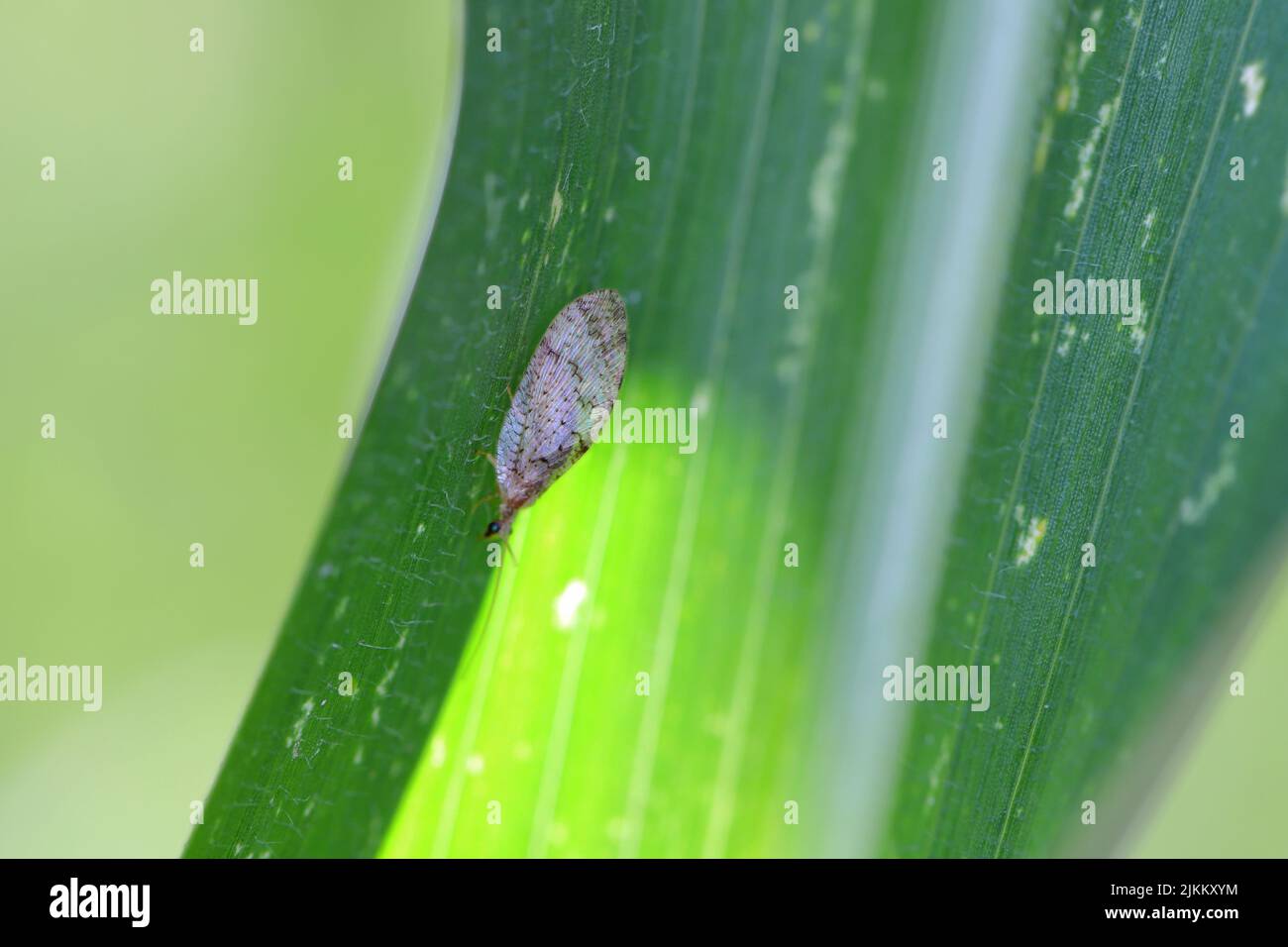 Brown lacewing (Hemerobius humulinus) adult on maize leaf. Stock Photohttps://www.alamy.com/image-license-details/?v=1https://www.alamy.com/brown-lacewing-hemerobius-humulinus-adult-on-maize-leaf-image476796648.html
Brown lacewing (Hemerobius humulinus) adult on maize leaf. Stock Photohttps://www.alamy.com/image-license-details/?v=1https://www.alamy.com/brown-lacewing-hemerobius-humulinus-adult-on-maize-leaf-image476796648.htmlRF2JKKXYM–Brown lacewing (Hemerobius humulinus) adult on maize leaf.
 Pyrochroa coccinea cardinal beetle larva. Head and mandibles of insect in the family Pyrochroidae, showing flattened shape Stock Photohttps://www.alamy.com/image-license-details/?v=1https://www.alamy.com/stock-photo-pyrochroa-coccinea-cardinal-beetle-larva-head-and-mandibles-of-insect-130496482.html
Pyrochroa coccinea cardinal beetle larva. Head and mandibles of insect in the family Pyrochroidae, showing flattened shape Stock Photohttps://www.alamy.com/image-license-details/?v=1https://www.alamy.com/stock-photo-pyrochroa-coccinea-cardinal-beetle-larva-head-and-mandibles-of-insect-130496482.htmlRFHG8HGJ–Pyrochroa coccinea cardinal beetle larva. Head and mandibles of insect in the family Pyrochroidae, showing flattened shape
 Awl fly larva on rotten wood (Xylophagus sp). Stock Photohttps://www.alamy.com/image-license-details/?v=1https://www.alamy.com/awl-fly-larva-on-rotten-wood-xylophagus-sp-image502796244.html
Awl fly larva on rotten wood (Xylophagus sp). Stock Photohttps://www.alamy.com/image-license-details/?v=1https://www.alamy.com/awl-fly-larva-on-rotten-wood-xylophagus-sp-image502796244.htmlRF2M609MM–Awl fly larva on rotten wood (Xylophagus sp).
 A larva of the green tiger beetle (Cicindela campestris) waits in its burrow for prey to wander by. Stock Photohttps://www.alamy.com/image-license-details/?v=1https://www.alamy.com/a-larva-of-the-green-tiger-beetle-cicindela-campestris-waits-in-its-burrow-for-prey-to-wander-by-image547032948.html
A larva of the green tiger beetle (Cicindela campestris) waits in its burrow for prey to wander by. Stock Photohttps://www.alamy.com/image-license-details/?v=1https://www.alamy.com/a-larva-of-the-green-tiger-beetle-cicindela-campestris-waits-in-its-burrow-for-prey-to-wander-by-image547032948.htmlRM2PNYE30–A larva of the green tiger beetle (Cicindela campestris) waits in its burrow for prey to wander by.
 Dragonfly larvae - Southern Hawker (Aeshna cyanea). Stock Photohttps://www.alamy.com/image-license-details/?v=1https://www.alamy.com/dragonfly-larvae-southern-hawker-aeshna-cyanea-image7385295.html
Dragonfly larvae - Southern Hawker (Aeshna cyanea). Stock Photohttps://www.alamy.com/image-license-details/?v=1https://www.alamy.com/dragonfly-larvae-southern-hawker-aeshna-cyanea-image7385295.htmlRMABMBW0–Dragonfly larvae - Southern Hawker (Aeshna cyanea).
 Lygistopterus sanguineus larva, larvae (Predatory) on wood. Net-winged beetles in the family Lycidae. Stock Photohttps://www.alamy.com/image-license-details/?v=1https://www.alamy.com/lygistopterus-sanguineus-larva-larvae-predatory-on-wood-net-winged-beetles-in-the-family-lycidae-image552098959.html
Lygistopterus sanguineus larva, larvae (Predatory) on wood. Net-winged beetles in the family Lycidae. Stock Photohttps://www.alamy.com/image-license-details/?v=1https://www.alamy.com/lygistopterus-sanguineus-larva-larvae-predatory-on-wood-net-winged-beetles-in-the-family-lycidae-image552098959.htmlRF2R267RY–Lygistopterus sanguineus larva, larvae (Predatory) on wood. Net-winged beetles in the family Lycidae.
 dragonfly nymph casing Stock Photohttps://www.alamy.com/image-license-details/?v=1https://www.alamy.com/dragonfly-nymph-casing-image212189396.html
dragonfly nymph casing Stock Photohttps://www.alamy.com/image-license-details/?v=1https://www.alamy.com/dragonfly-nymph-casing-image212189396.htmlRFP961MM–dragonfly nymph casing
 A larva of the world’s largest firefly from the Lamprigera genus feeding on a snail in the forest floor Stock Photohttps://www.alamy.com/image-license-details/?v=1https://www.alamy.com/a-larva-of-the-worlds-largest-firefly-from-the-lamprigera-genus-feeding-on-a-snail-in-the-forest-floor-image243216856.html
A larva of the world’s largest firefly from the Lamprigera genus feeding on a snail in the forest floor Stock Photohttps://www.alamy.com/image-license-details/?v=1https://www.alamy.com/a-larva-of-the-worlds-largest-firefly-from-the-lamprigera-genus-feeding-on-a-snail-in-the-forest-floor-image243216856.htmlRFT3KDG8–A larva of the world’s largest firefly from the Lamprigera genus feeding on a snail in the forest floor
 dragonfly nymph casing Stock Photohttps://www.alamy.com/image-license-details/?v=1https://www.alamy.com/dragonfly-nymph-casing-image212189399.html
dragonfly nymph casing Stock Photohttps://www.alamy.com/image-license-details/?v=1https://www.alamy.com/dragonfly-nymph-casing-image212189399.htmlRFP961MR–dragonfly nymph casing
 European hornet worker (Vespa crabro) busy constructing a nest. Stock Photohttps://www.alamy.com/image-license-details/?v=1https://www.alamy.com/stock-photo-european-hornet-worker-vespa-crabro-busy-constructing-a-nest-147805322.html
European hornet worker (Vespa crabro) busy constructing a nest. Stock Photohttps://www.alamy.com/image-license-details/?v=1https://www.alamy.com/stock-photo-european-hornet-worker-vespa-crabro-busy-constructing-a-nest-147805322.htmlRFJGD35E–European hornet worker (Vespa crabro) busy constructing a nest.
 Larvae of Green tiger beetle, Cicindela campestris living in a group on damp heathland, Dorset. Stock Photohttps://www.alamy.com/image-license-details/?v=1https://www.alamy.com/larvae-of-green-tiger-beetle-cicindela-campestris-living-in-a-group-on-damp-heathland-dorset-image574635444.html
Larvae of Green tiger beetle, Cicindela campestris living in a group on damp heathland, Dorset. Stock Photohttps://www.alamy.com/image-license-details/?v=1https://www.alamy.com/larvae-of-green-tiger-beetle-cicindela-campestris-living-in-a-group-on-damp-heathland-dorset-image574635444.htmlRM2TATWAC–Larvae of Green tiger beetle, Cicindela campestris living in a group on damp heathland, Dorset.
 Myrmeleonidae - Antlion insect in the family Myrmeleontidae, known for the fiercely predatory habits of their larvae, which in many species dig pits Stock Photohttps://www.alamy.com/image-license-details/?v=1https://www.alamy.com/myrmeleonidae-antlion-insect-in-the-family-myrmeleontidae-known-for-the-fiercely-predatory-habits-of-their-larvae-which-in-many-species-dig-pits-image262848926.html
Myrmeleonidae - Antlion insect in the family Myrmeleontidae, known for the fiercely predatory habits of their larvae, which in many species dig pits Stock Photohttps://www.alamy.com/image-license-details/?v=1https://www.alamy.com/myrmeleonidae-antlion-insect-in-the-family-myrmeleontidae-known-for-the-fiercely-predatory-habits-of-their-larvae-which-in-many-species-dig-pits-image262848926.htmlRFW7HPDJ–Myrmeleonidae - Antlion insect in the family Myrmeleontidae, known for the fiercely predatory habits of their larvae, which in many species dig pits
 Lacewing Stock Photohttps://www.alamy.com/image-license-details/?v=1https://www.alamy.com/lacewing-image339059777.html
Lacewing Stock Photohttps://www.alamy.com/image-license-details/?v=1https://www.alamy.com/lacewing-image339059777.htmlRF2AKHE5N–Lacewing
 Snakefly larvae Stock Photohttps://www.alamy.com/image-license-details/?v=1https://www.alamy.com/snakefly-larvae-image449650226.html
Snakefly larvae Stock Photohttps://www.alamy.com/image-license-details/?v=1https://www.alamy.com/snakefly-larvae-image449650226.htmlRF2H3F9CJ–Snakefly larvae
 Marmalade Hoverfly feeding on Hairy Willowherb pollen. Collinswoodimages. Stock Photohttps://www.alamy.com/image-license-details/?v=1https://www.alamy.com/marmalade-hoverfly-feeding-on-hairy-willowherb-pollen-collinswoodimages-image624306213.html
Marmalade Hoverfly feeding on Hairy Willowherb pollen. Collinswoodimages. Stock Photohttps://www.alamy.com/image-license-details/?v=1https://www.alamy.com/marmalade-hoverfly-feeding-on-hairy-willowherb-pollen-collinswoodimages-image624306213.htmlRF2Y7KGXD–Marmalade Hoverfly feeding on Hairy Willowherb pollen. Collinswoodimages.
 June 16, 2013 - Fort Worth, Texas, USA - June 16, 2013 Fort Worth, Tx. USA. A Flame Skimmer dragonfly rests on an antena in Fort Worth, Tx. Dragonfly are predatory insects with the young feeding on larvae such as mosquito and fly larvae and the adults feed on any soft bodied insects they encounter such moths, flies or ants. (Credit Image: © Ralph Lauer/ZUMAPRESS.com) Stock Photohttps://www.alamy.com/image-license-details/?v=1https://www.alamy.com/stock-photo-june-16-2013-fort-worth-texas-usa-june-16-2013-fort-worth-tx-usa-a-57393833.html
June 16, 2013 - Fort Worth, Texas, USA - June 16, 2013 Fort Worth, Tx. USA. A Flame Skimmer dragonfly rests on an antena in Fort Worth, Tx. Dragonfly are predatory insects with the young feeding on larvae such as mosquito and fly larvae and the adults feed on any soft bodied insects they encounter such moths, flies or ants. (Credit Image: © Ralph Lauer/ZUMAPRESS.com) Stock Photohttps://www.alamy.com/image-license-details/?v=1https://www.alamy.com/stock-photo-june-16-2013-fort-worth-texas-usa-june-16-2013-fort-worth-tx-usa-a-57393833.htmlRMD9AEBN–June 16, 2013 - Fort Worth, Texas, USA - June 16, 2013 Fort Worth, Tx. USA. A Flame Skimmer dragonfly rests on an antena in Fort Worth, Tx. Dragonfly are predatory insects with the young feeding on larvae such as mosquito and fly larvae and the adults feed on any soft bodied insects they encounter such moths, flies or ants. (Credit Image: © Ralph Lauer/ZUMAPRESS.com)
 Marmalade Hoverfly feeding on Rose-of-sharon flower in a Manchester garden.Collinswoodimages. Stock Photohttps://www.alamy.com/image-license-details/?v=1https://www.alamy.com/marmalade-hoverfly-feeding-on-rose-of-sharon-flower-in-a-manchester-gardencollinswoodimages-image624306278.html
Marmalade Hoverfly feeding on Rose-of-sharon flower in a Manchester garden.Collinswoodimages. Stock Photohttps://www.alamy.com/image-license-details/?v=1https://www.alamy.com/marmalade-hoverfly-feeding-on-rose-of-sharon-flower-in-a-manchester-gardencollinswoodimages-image624306278.htmlRF2Y7KH0P–Marmalade Hoverfly feeding on Rose-of-sharon flower in a Manchester garden.Collinswoodimages.
 common blue damselfly on a green pond reed Stock Photohttps://www.alamy.com/image-license-details/?v=1https://www.alamy.com/common-blue-damselfly-on-a-green-pond-reed-image553557580.html
common blue damselfly on a green pond reed Stock Photohttps://www.alamy.com/image-license-details/?v=1https://www.alamy.com/common-blue-damselfly-on-a-green-pond-reed-image553557580.htmlRF2R4GM9G–common blue damselfly on a green pond reed
 Inside of a yellow jacket wasp nest with larvae and eggs in cells of hive closeup macro Stock Photohttps://www.alamy.com/image-license-details/?v=1https://www.alamy.com/stock-photo-inside-of-a-yellow-jacket-wasp-nest-with-larvae-and-eggs-in-cells-111768850.html
Inside of a yellow jacket wasp nest with larvae and eggs in cells of hive closeup macro Stock Photohttps://www.alamy.com/image-license-details/?v=1https://www.alamy.com/stock-photo-inside-of-a-yellow-jacket-wasp-nest-with-larvae-and-eggs-in-cells-111768850.htmlRFGDRE8J–Inside of a yellow jacket wasp nest with larvae and eggs in cells of hive closeup macro
 Marmalade Hoverfly feeding on Hairy Willowherb pollen. Collinswoodimages. Stock Photohttps://www.alamy.com/image-license-details/?v=1https://www.alamy.com/marmalade-hoverfly-feeding-on-hairy-willowherb-pollen-collinswoodimages-image624306871.html
Marmalade Hoverfly feeding on Hairy Willowherb pollen. Collinswoodimages. Stock Photohttps://www.alamy.com/image-license-details/?v=1https://www.alamy.com/marmalade-hoverfly-feeding-on-hairy-willowherb-pollen-collinswoodimages-image624306871.htmlRF2Y7KHNY–Marmalade Hoverfly feeding on Hairy Willowherb pollen. Collinswoodimages.
 Antlion larva, Doodlebug Stock Photohttps://www.alamy.com/image-license-details/?v=1https://www.alamy.com/antlion-larva-doodlebug-image337476227.html
Antlion larva, Doodlebug Stock Photohttps://www.alamy.com/image-license-details/?v=1https://www.alamy.com/antlion-larva-doodlebug-image337476227.htmlRM2AH1AAB–Antlion larva, Doodlebug
 Three specimens of mosquito larvae or wrigglers of the species called Toxorhynchites speciosus, which is a large mosquito that feed on plant sap and n Stock Photohttps://www.alamy.com/image-license-details/?v=1https://www.alamy.com/three-specimens-of-mosquito-larvae-or-wrigglers-of-the-species-called-toxorhynchites-speciosus-which-is-a-large-mosquito-that-feed-on-plant-sap-and-n-image229054842.html
Three specimens of mosquito larvae or wrigglers of the species called Toxorhynchites speciosus, which is a large mosquito that feed on plant sap and n Stock Photohttps://www.alamy.com/image-license-details/?v=1https://www.alamy.com/three-specimens-of-mosquito-larvae-or-wrigglers-of-the-species-called-toxorhynchites-speciosus-which-is-a-large-mosquito-that-feed-on-plant-sap-and-n-image229054842.htmlRFR8J9P2–Three specimens of mosquito larvae or wrigglers of the species called Toxorhynchites speciosus, which is a large mosquito that feed on plant sap and n
 New Zealand glow worm larvae (Arachnocampa luminosa) Stock Photohttps://www.alamy.com/image-license-details/?v=1https://www.alamy.com/new-zealand-glow-worm-larvae-arachnocampa-luminosa-image555813741.html
New Zealand glow worm larvae (Arachnocampa luminosa) Stock Photohttps://www.alamy.com/image-license-details/?v=1https://www.alamy.com/new-zealand-glow-worm-larvae-arachnocampa-luminosa-image555813741.htmlRF2R87E2N–New Zealand glow worm larvae (Arachnocampa luminosa)
 White-faced Darter (Leucorrhinia dubia) larva. Stock Photohttps://www.alamy.com/image-license-details/?v=1https://www.alamy.com/stock-photo-white-faced-darter-leucorrhinia-dubia-larva-11758760.html
White-faced Darter (Leucorrhinia dubia) larva. Stock Photohttps://www.alamy.com/image-license-details/?v=1https://www.alamy.com/stock-photo-white-faced-darter-leucorrhinia-dubia-larva-11758760.htmlRMA78EYN–White-faced Darter (Leucorrhinia dubia) larva.
 Lygistopterus sanguineus larva, larvae (Predatory) on wood. Net-winged beetles in the family Lycidae. Stock Photohttps://www.alamy.com/image-license-details/?v=1https://www.alamy.com/lygistopterus-sanguineus-larva-larvae-predatory-on-wood-net-winged-beetles-in-the-family-lycidae-image552099102.html
Lygistopterus sanguineus larva, larvae (Predatory) on wood. Net-winged beetles in the family Lycidae. Stock Photohttps://www.alamy.com/image-license-details/?v=1https://www.alamy.com/lygistopterus-sanguineus-larva-larvae-predatory-on-wood-net-winged-beetles-in-the-family-lycidae-image552099102.htmlRF2R26812–Lygistopterus sanguineus larva, larvae (Predatory) on wood. Net-winged beetles in the family Lycidae.
 The predatory shield bug species Picromerus bidens with prey Stock Photohttps://www.alamy.com/image-license-details/?v=1https://www.alamy.com/stock-photo-the-predatory-shield-bug-species-picromerus-bidens-with-prey-48148593.html
The predatory shield bug species Picromerus bidens with prey Stock Photohttps://www.alamy.com/image-license-details/?v=1https://www.alamy.com/stock-photo-the-predatory-shield-bug-species-picromerus-bidens-with-prey-48148593.htmlRMCP9A0H–The predatory shield bug species Picromerus bidens with prey
 A larva of the world’s largest firefly from the Lamprigera genus feeding on a snail in the forest floor Stock Photohttps://www.alamy.com/image-license-details/?v=1https://www.alamy.com/a-larva-of-the-worlds-largest-firefly-from-the-lamprigera-genus-feeding-on-a-snail-in-the-forest-floor-image243216835.html
A larva of the world’s largest firefly from the Lamprigera genus feeding on a snail in the forest floor Stock Photohttps://www.alamy.com/image-license-details/?v=1https://www.alamy.com/a-larva-of-the-worlds-largest-firefly-from-the-lamprigera-genus-feeding-on-a-snail-in-the-forest-floor-image243216835.htmlRFT3KDFF–A larva of the world’s largest firefly from the Lamprigera genus feeding on a snail in the forest floor
 dragonfly nymph casing Stock Photohttps://www.alamy.com/image-license-details/?v=1https://www.alamy.com/dragonfly-nymph-casing-image212189403.html
dragonfly nymph casing Stock Photohttps://www.alamy.com/image-license-details/?v=1https://www.alamy.com/dragonfly-nymph-casing-image212189403.htmlRFP961MY–dragonfly nymph casing
 European hornet worker (Vespa crabro) busy constructing a nest. Stock Photohttps://www.alamy.com/image-license-details/?v=1https://www.alamy.com/stock-photo-european-hornet-worker-vespa-crabro-busy-constructing-a-nest-147805327.html
European hornet worker (Vespa crabro) busy constructing a nest. Stock Photohttps://www.alamy.com/image-license-details/?v=1https://www.alamy.com/stock-photo-european-hornet-worker-vespa-crabro-busy-constructing-a-nest-147805327.htmlRFJGD35K–European hornet worker (Vespa crabro) busy constructing a nest.
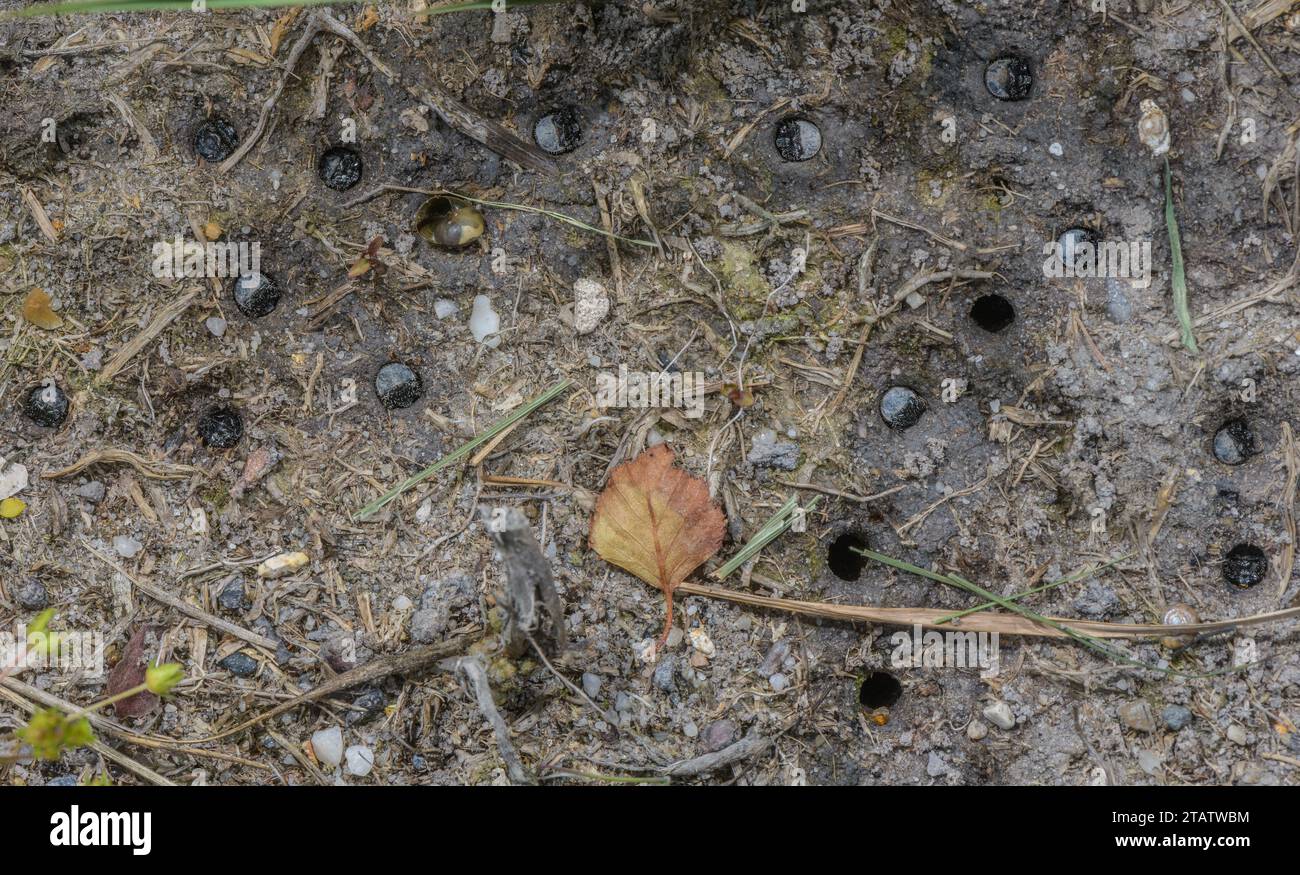 Larvae of Green tiger beetle, Cicindela campestris living in a group on damp heathland, Dorset. Stock Photohttps://www.alamy.com/image-license-details/?v=1https://www.alamy.com/larvae-of-green-tiger-beetle-cicindela-campestris-living-in-a-group-on-damp-heathland-dorset-image574635480.html
Larvae of Green tiger beetle, Cicindela campestris living in a group on damp heathland, Dorset. Stock Photohttps://www.alamy.com/image-license-details/?v=1https://www.alamy.com/larvae-of-green-tiger-beetle-cicindela-campestris-living-in-a-group-on-damp-heathland-dorset-image574635480.htmlRM2TATWBM–Larvae of Green tiger beetle, Cicindela campestris living in a group on damp heathland, Dorset.
 photo shows the larvae and pupa of the ladybug Stock Photohttps://www.alamy.com/image-license-details/?v=1https://www.alamy.com/photo-shows-the-larvae-and-pupa-of-the-ladybug-image469070784.html
photo shows the larvae and pupa of the ladybug Stock Photohttps://www.alamy.com/image-license-details/?v=1https://www.alamy.com/photo-shows-the-larvae-and-pupa-of-the-ladybug-image469070784.htmlRF2J740G0–photo shows the larvae and pupa of the ladybug
 A rove or staphylinid beetle Ontholestes murinus a predator of fly larvae Stock Photohttps://www.alamy.com/image-license-details/?v=1https://www.alamy.com/a-rove-or-staphylinid-beetle-ontholestes-murinus-a-predator-of-fly-image9020506.html
A rove or staphylinid beetle Ontholestes murinus a predator of fly larvae Stock Photohttps://www.alamy.com/image-license-details/?v=1https://www.alamy.com/a-rove-or-staphylinid-beetle-ontholestes-murinus-a-predator-of-fly-image9020506.htmlRMAPGGNB–A rove or staphylinid beetle Ontholestes murinus a predator of fly larvae
 Snakefly larvae Stock Photohttps://www.alamy.com/image-license-details/?v=1https://www.alamy.com/snakefly-larvae-image449650315.html
Snakefly larvae Stock Photohttps://www.alamy.com/image-license-details/?v=1https://www.alamy.com/snakefly-larvae-image449650315.htmlRF2H3F9FR–Snakefly larvae
 Predatory ladybird Delphastus pusillus feeding on whitefly Trialeurodes vaporariorum Stock Photohttps://www.alamy.com/image-license-details/?v=1https://www.alamy.com/stock-photo-predatory-ladybird-delphastus-pusillus-feeding-on-whitefly-trialeurodes-11179679.html
Predatory ladybird Delphastus pusillus feeding on whitefly Trialeurodes vaporariorum Stock Photohttps://www.alamy.com/image-license-details/?v=1https://www.alamy.com/stock-photo-predatory-ladybird-delphastus-pusillus-feeding-on-whitefly-trialeurodes-11179679.htmlRMA52YET–Predatory ladybird Delphastus pusillus feeding on whitefly Trialeurodes vaporariorum
 June 16, 2013 - Fort Worth, Texas, USA - June 16, 2013 Fort Worth, Tx. USA. A Flame Skimmer dragonfly rests on a car antenna in Fort Worth, Tx. Dragonfly are predatory insects with the young feeding on larvae such as mosquito and fly larvae and the adults feed on any soft bodied insects they encounter such moths, flies or ants. (Credit Image: © Ralph Lauer/ZUMAPRESS.com) Stock Photohttps://www.alamy.com/image-license-details/?v=1https://www.alamy.com/stock-photo-june-16-2013-fort-worth-texas-usa-june-16-2013-fort-worth-tx-usa-a-57393814.html
June 16, 2013 - Fort Worth, Texas, USA - June 16, 2013 Fort Worth, Tx. USA. A Flame Skimmer dragonfly rests on a car antenna in Fort Worth, Tx. Dragonfly are predatory insects with the young feeding on larvae such as mosquito and fly larvae and the adults feed on any soft bodied insects they encounter such moths, flies or ants. (Credit Image: © Ralph Lauer/ZUMAPRESS.com) Stock Photohttps://www.alamy.com/image-license-details/?v=1https://www.alamy.com/stock-photo-june-16-2013-fort-worth-texas-usa-june-16-2013-fort-worth-tx-usa-a-57393814.htmlRMD9AEB2–June 16, 2013 - Fort Worth, Texas, USA - June 16, 2013 Fort Worth, Tx. USA. A Flame Skimmer dragonfly rests on a car antenna in Fort Worth, Tx. Dragonfly are predatory insects with the young feeding on larvae such as mosquito and fly larvae and the adults feed on any soft bodied insects they encounter such moths, flies or ants. (Credit Image: © Ralph Lauer/ZUMAPRESS.com)
 Unidentified clawed harvestman (family Sclerosomatidae, Prionostemma sp.?) has caught a small insect larvae as food. Stock Photohttps://www.alamy.com/image-license-details/?v=1https://www.alamy.com/unidentified-clawed-harvestman-family-sclerosomatidae-prionostemma-sp-has-caught-a-small-insect-larvae-as-food-image596549815.html
Unidentified clawed harvestman (family Sclerosomatidae, Prionostemma sp.?) has caught a small insect larvae as food. Stock Photohttps://www.alamy.com/image-license-details/?v=1https://www.alamy.com/unidentified-clawed-harvestman-family-sclerosomatidae-prionostemma-sp-has-caught-a-small-insect-larvae-as-food-image596549815.htmlRM2WJF5AF–Unidentified clawed harvestman (family Sclerosomatidae, Prionostemma sp.?) has caught a small insect larvae as food.
 Damselfly resting on leaves Stock Photohttps://www.alamy.com/image-license-details/?v=1https://www.alamy.com/damselfly-resting-on-leaves-image553557333.html
Damselfly resting on leaves Stock Photohttps://www.alamy.com/image-license-details/?v=1https://www.alamy.com/damselfly-resting-on-leaves-image553557333.htmlRF2R4GM0N–Damselfly resting on leaves
 Wasp Nest on the ground with larvae and eggs in individual cell of the hive side view closeup macro Stock Photohttps://www.alamy.com/image-license-details/?v=1https://www.alamy.com/stock-photo-wasp-nest-on-the-ground-with-larvae-and-eggs-in-individual-cell-of-111768847.html
Wasp Nest on the ground with larvae and eggs in individual cell of the hive side view closeup macro Stock Photohttps://www.alamy.com/image-license-details/?v=1https://www.alamy.com/stock-photo-wasp-nest-on-the-ground-with-larvae-and-eggs-in-individual-cell-of-111768847.htmlRFGDRE8F–Wasp Nest on the ground with larvae and eggs in individual cell of the hive side view closeup macro